By Kira Kinney
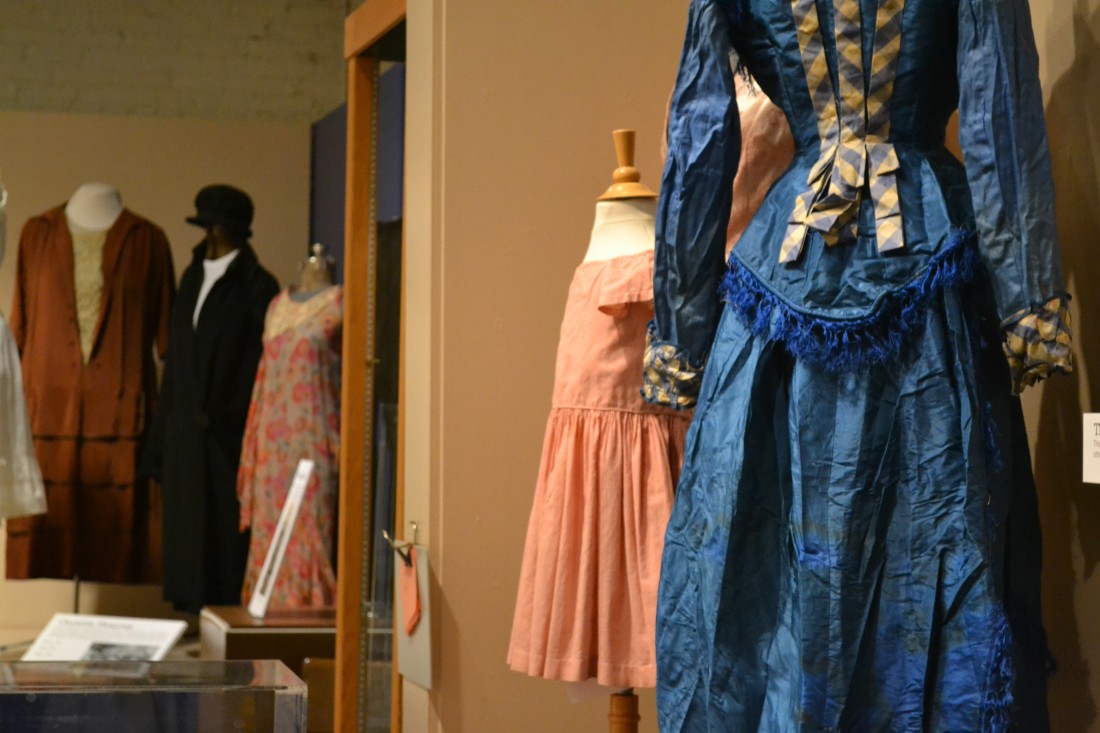



The History of Clothing in the past 150 years has been one of constant change. Everything from dresses to uniforms to undergarments has had to evolve with the times. These garments from our What We Wore exhibit are just a taste of what people used to consider every day fashion in their respective time. Whether it’s viewing what these fashions were or the people that wore them, each piece of clothing has it’s own history.
Aprons
Apron, c. 1940
WHC M3 2003-003-0022
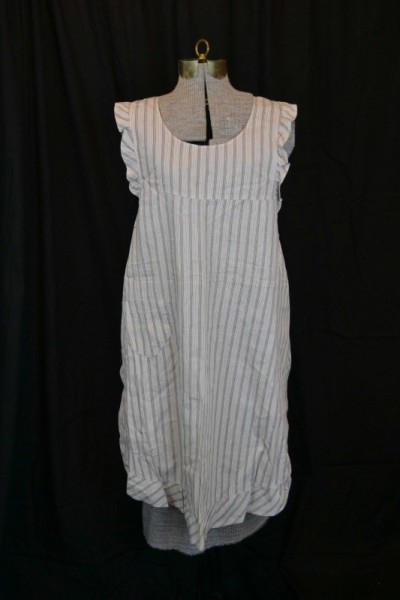
This apron belonged to Clara Wolf. She worked as a mender at the Thomas Kay Woolen Mill. The apron would have been used to protect her clothes from tufts of wool that would very easily stick to clothing.
Apron. Date Unknown
WHC 0999.072
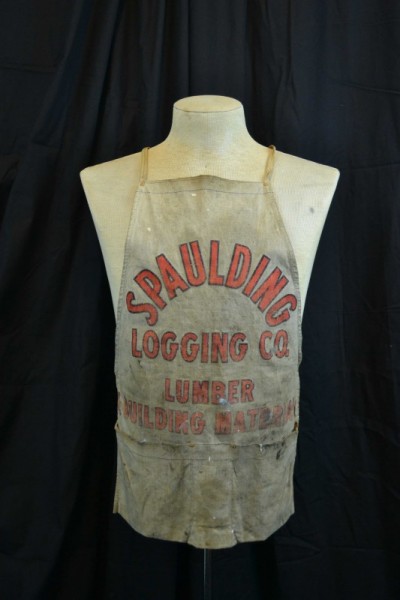
This is a canvas-like cloth apron, with pockets for nails and tools. The front advertises, in red letters outlined in black, “Spaulding Logging Co. Lumber and Building Materials”, which was a Salem area business.
Mill Gear
WHC 2009.088
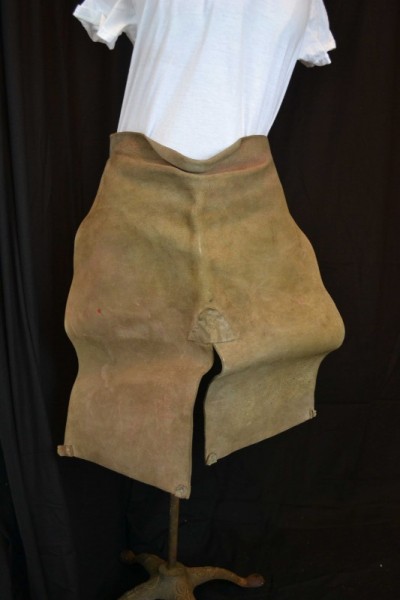
The apron above belonged to Jacob Neufeld (1919-2005). He worked at the plywood mill in Valsetz for 42 years; up until two months before its closing in 1984. His apron would have protected him from the mill machinery.
Glasses
Welding Goggles
WHC M3 1991-200-0087
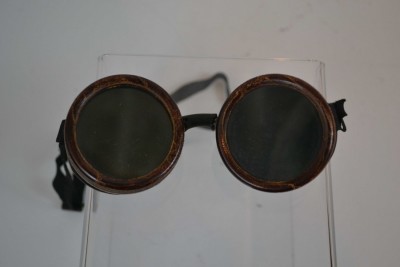
These glasses were found in the Thomas Kay Woolen Mill Machine Shop on site. They most likely would have been used for when repairs needing welding would have been required on the various machines in the mill.
Jewelry
Medal
WHC 0081.023.0008.013.02
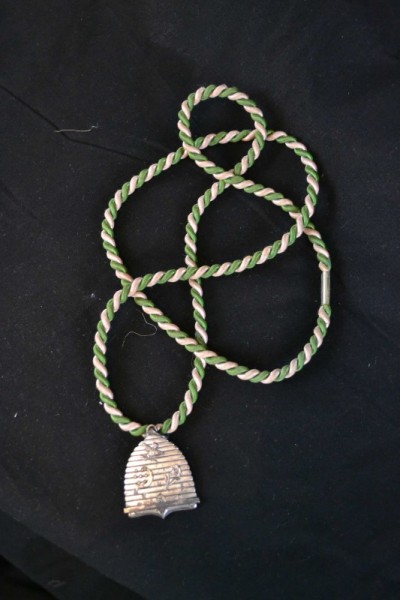
This sterling silver medal is an Odd Fellows subordinate order medallion. There are the letters: F, L, T on the medal and the saying “We command you to visit the sick, relieve the distressed, bury the dead and educate the orphaned”. “Odd Fellows 1834” is on the other side.
Wristwatch c. 1940
WHC 1991.021.0023
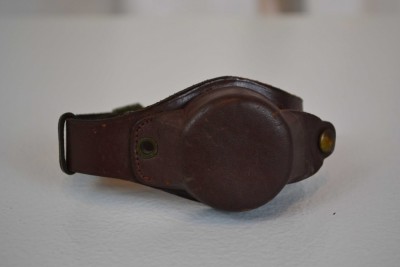
This is a brown leather wrist watch bank. It has a protective covering over the watch that snaps open and shut in order to protect the watch itself from the elements. The undercover is stamped with: Pat. 5/1/1940 No. 112154.
Watch Chain
WHC M3 1991-200-0978
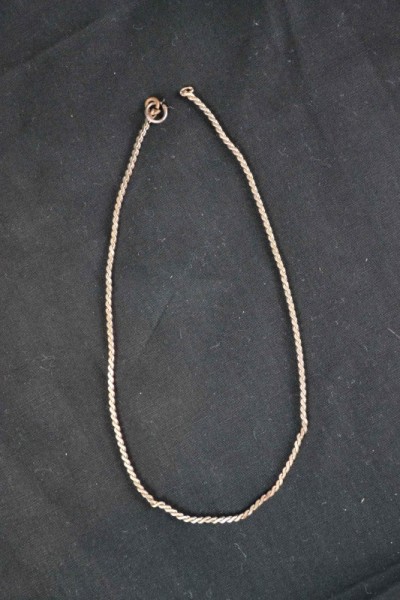
The chain fragment seen above was found on the mill site, most likely belonging to a former worker. Chains were often used to keep track of pocket watches.
Men’s Accessories
Detachable Cuffs, c. 1887
WHC 0081.023.0026.005
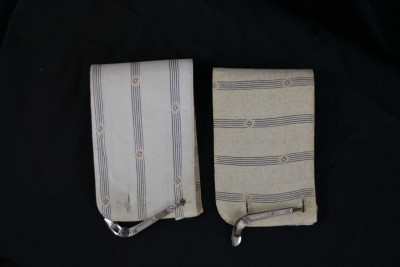
Detachable cuffs were a popular men’s accessory starting in the mid 19th century. They were used to make plain shirts look more expensive and high fashion.
White Button Collar c. 1887
WHC 0081.023.0026.005a
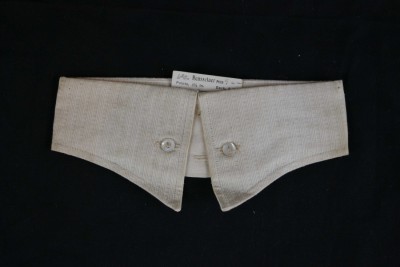
This fashion started in the mid 19th century. The collar was attached via buttons in the front and back of the shirt and collar.
Removable Collar, c. 1900
WHC 0081.023.0026.0005, X2013.006.0003
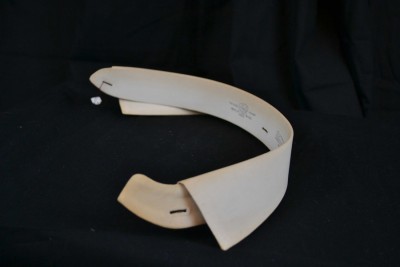
Legend has it that removable collars were invented by a housewife who was tired of washing her husband’s shirts. The collar is one of the areas of a shirt that gets dirty fastest. A removable collar could be switched out providing a clean appearance without having to wash or replace the entire shirt.
Spats c. 1916
WHC 1984.028.0004a,b
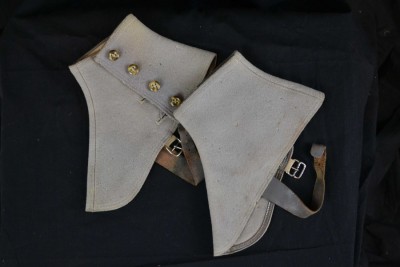
This 19th century piece of fashion was made both for style and practicality. As well as being stylish, spats were used to protect shoes and socks from mud, dirt, or rain. In the 18th century, spats could be as high as mid thigh. But by the 1900s, they had been shortened down to the ankle.
Rings
Ring
WHC 0084.045.0014c
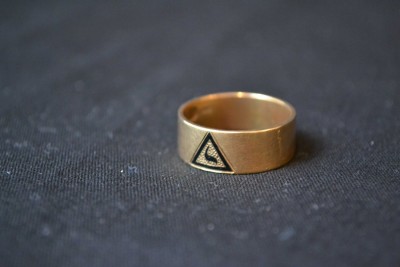
This is a Masonic ring of the 14th degree. It has a black enamel symbol in a triangle on the wide band. This ring was made by “The L. C. Henricksen Company, Gold and Silver Smith, Portland, Oregon”. The inscription on the interior reads: “Virtus Junxit Mors Non Separabit”, which is the motto for the 14th degree of Freemasonry.
Ring
WHC 0084.045.0014b
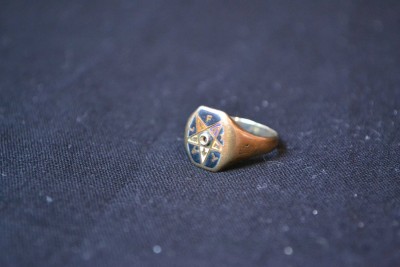
This ring is for the Masonic Order of the Eastern Star. Unlike most Freemason orders, women are able to participate in this order as long as they have a relation to a current Mason.
Robes
Judges Robes, c. 1965
WHC 2008.050.0001
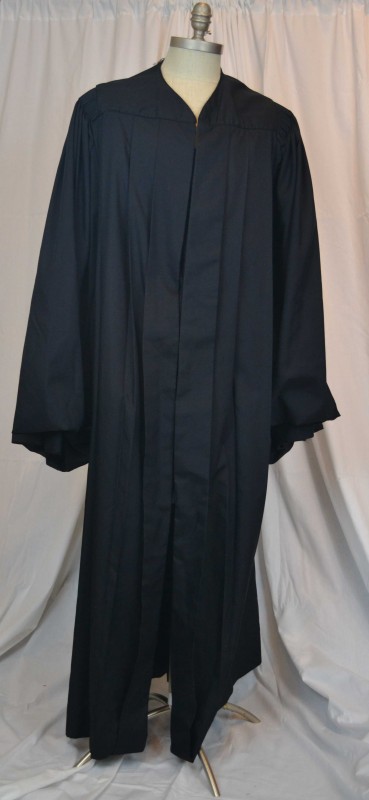
Joseph B. Felton was admitted to the Oregon State Bar in 1935 and went to work in the Marion County District Attorney’s Office and the Salem District Court. When WWII broke out, he was assigned as MP with the 70th Division Trailblazers at Camp Adair. He would serve as Marion County Circuit Court Judge from 1951 to 1977. His robes are shown above. During his tenure he served as leader of the National Council of Juvenile Court Judges.
Scarf
Boy Scout Uniform kerchief
WHC 1989.023.0007
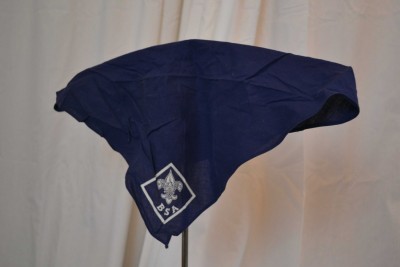
A noticeable part of the Boy Scouts of America uniform is their kerchief. It show the BSA emblem in white on the front.
Scarf
WHC 1989.069.0019
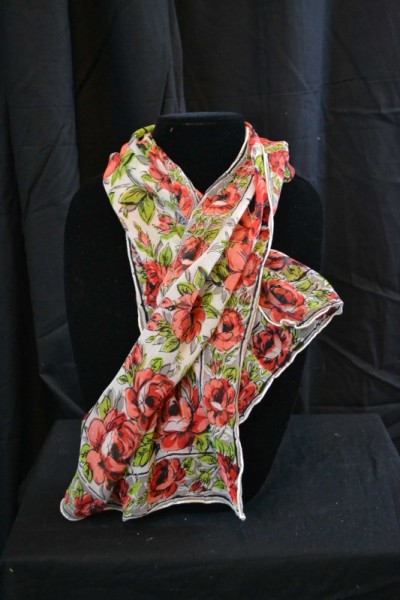
This is a chiffon scarf with a design of red flowers covering it. Scarfs like this have always been fairly versatile with their use, and can even be used outside of neck decoration.
Boy Scouts of America Scarf Clip Holder.
WHC 1989.023.0016
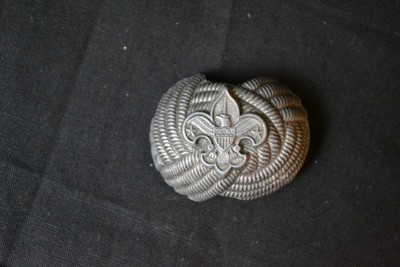
Clips like this were used as a decoration on ties and kerchiefs. The Boy Scouts of America’s Mission Statement: “The mission of the Boy Scouts of America is to prepare young people to make ethical and moral choices over their lifetimes by instilling in them the values of the Scout Oath and Law.”
Ties
Tie
WHC 2007.049.0001
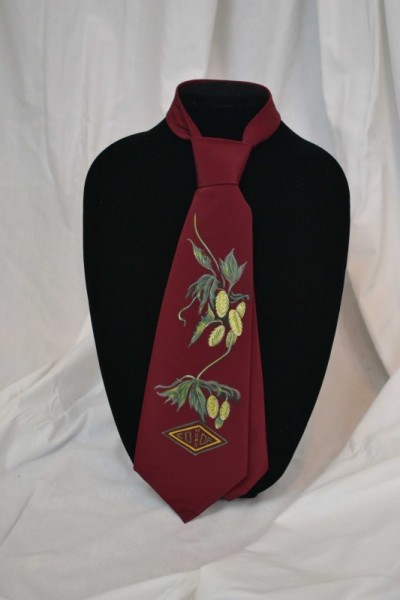
This maroon colored tie is pictured with hops which were hand painted in green and yellow on the front. It has a diamond shaped outline at the base of the tie and has the words “Hops Coop” written cross ways. The white tag on the back reads “Hand painted by Delores Armstrong”. The secondary beige tag reads: “Carstens Exclusive Menswear”.
The Oregon Hops Commission was created in 1964 as a way to promote and increase the research and education of hop production. Through agricultural research and financial evaluations, they work to maintain economic stability in the Oregon hops industry.
Bow Tie
WHC M3 1975-038-0028
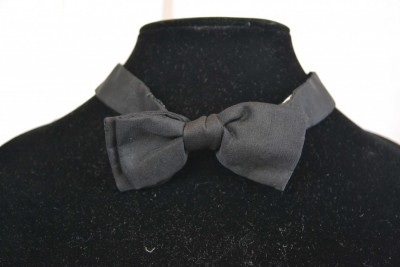
This is a men’s black, pre-tied bow tie. It is made with linen and has an elastic band and fastener to help with the ease of putting it on.
Bow Tie
WHC M3 1975-038-0027
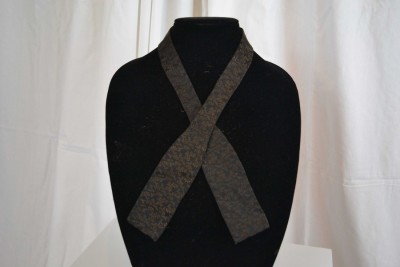
This is a men’s black brocade silk bow tie which is currently untied.The reason why this would be used for bow ties is because of the block-like ends on both sides and the very narrow middle. Regular ties end with a point on either side and are not as narrow in the middle.
Necktie
WHC 0081.023.0026.003b
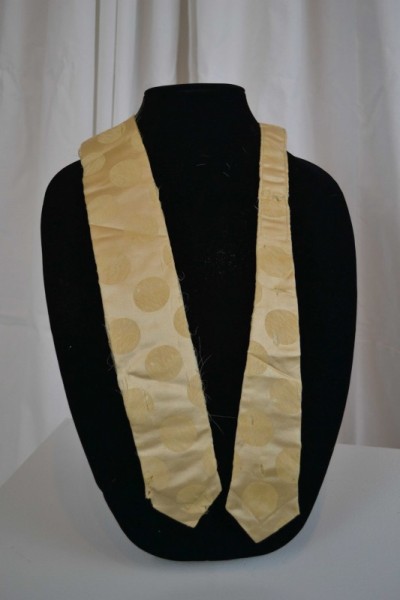
This gold colored tie is decorated with yellow circles.
Necktie
WHC 0081.023.0026.003a
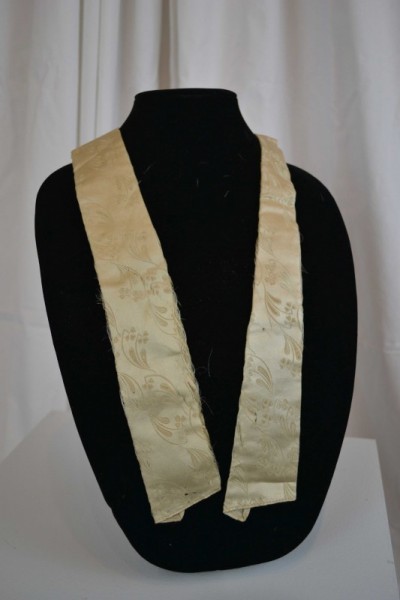
This gold color tie is covered with a floral design.
Necktie
WHC 0999.144
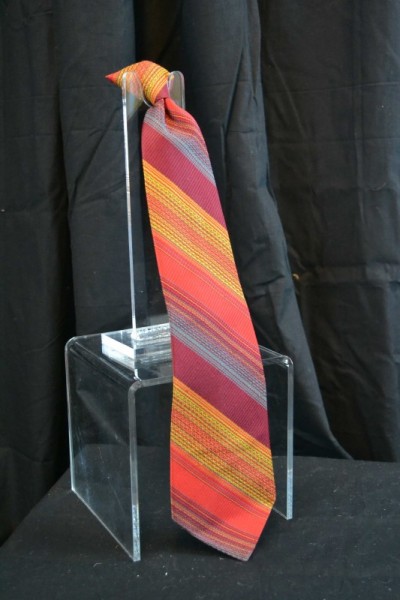
This is a red clip-on necktie. It is decorated with diagonal stripes of reds, blues, yellows, maroon. The clip-on tie is made of of polyester ‘terylene’.
Wedding Coat, 1892
WHC 0083.040.0002
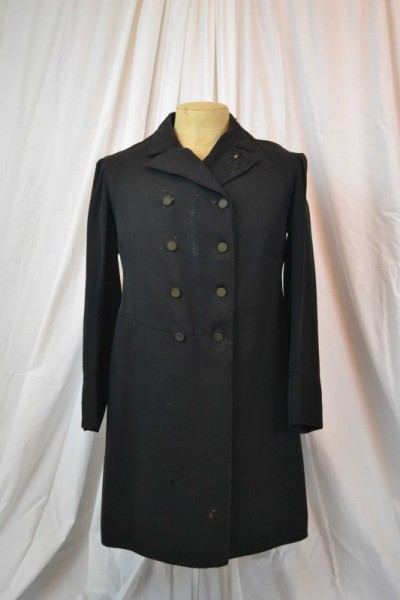
Gustav Carl Hillman (1868-1933) immigrated to the US from Germany via Brazil and Canada just before WWI. This coat was apparently important enough for him to bring it with him to his new home. He and his family settled down and farmed on Wheatland Road in what is now the Clear Lake area of Keizer.
Coat, c. 1925
WHC 2014.029.0002
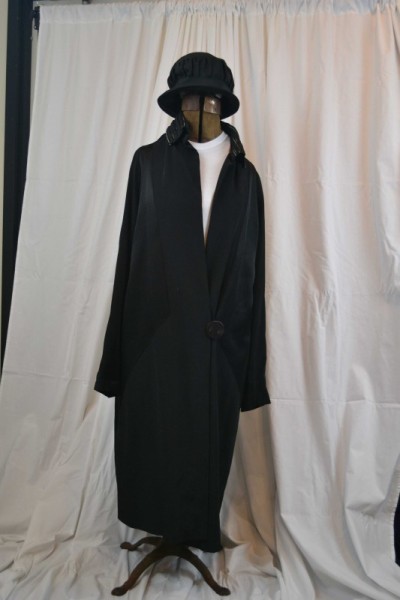
This is a black coat with grosgrain like material on the outside and cream crepe material inside. The collar is seven rows of black braids. The braids also go down the inside front facings. There is one large button to close in the front. This would have been used more by middle class women who were going out to do errands or visit friends in the middle of the day.
Wool Coat, c. 1950
WHC M3 2005-003-0001
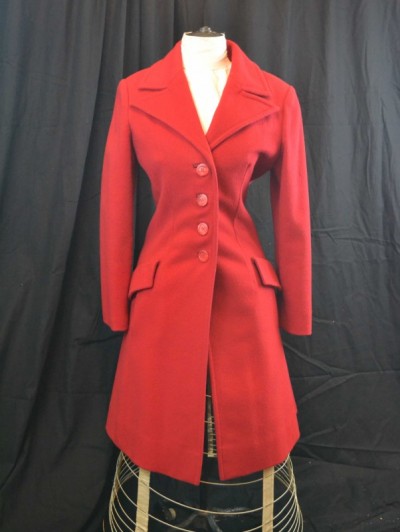
This coat has a Thomas Kay Woolen Mill tag in it. The fabric was likely made at the mill and the coat constructed elsewhere. It is a full length red wool coat with a princess style cut.
Women’s Formal Cape. Circa 1840- 1863
WHC M3 1974-009-0001
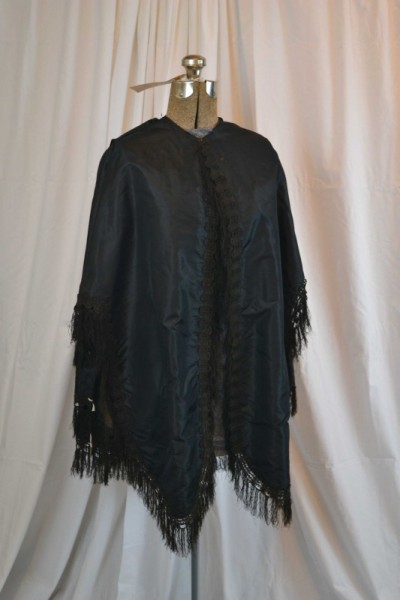
This cape is made with black taffeta silk and decorated with braid trim and fringes, and has a brown linen lining. This cape had distinctive Civil War era corded seams.
Oregon State Centennial Dress, 1959
WHC 2008.041.0002
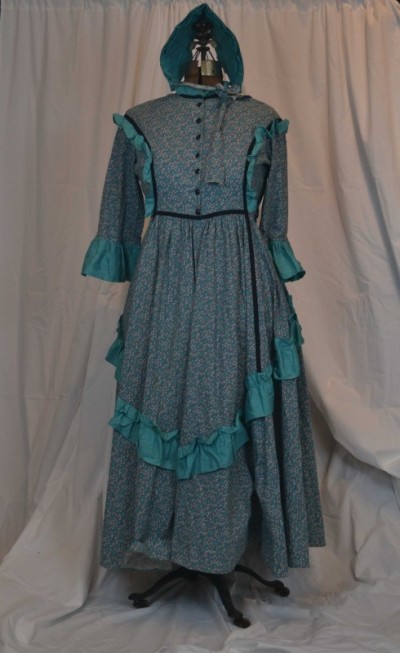
Martha Belle Smith Gretzinger was born in Tennessee in 1882. She and her family did not come to Oregon on a wagon train, and her ancestors never homesteaded here. In 1959, however, she showed her pride in her adopted home state by donning this dress to celebrate the hundredth anniversary of Oregon becoming a state.
In February 1959, the state of Oregon celebrated its 100th birthday. Different cities across the state celebrated in various ways, such as parades, expositions and pageants. These dresses were created and worn in the pioneer- themed pageant in Salem, Oregon.
Old Believer Dress, c. 1976
WHC 2009.020
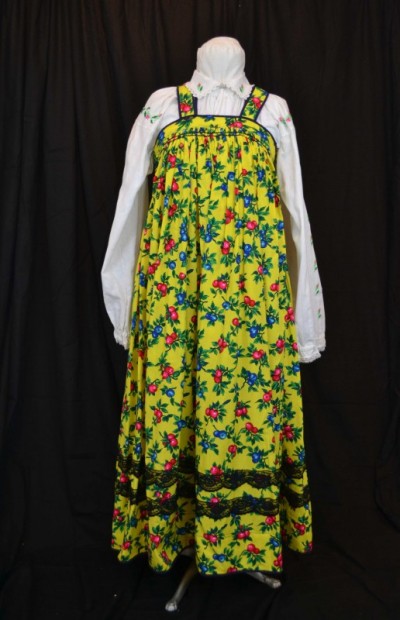
The Russian Old Believers are Russian Orthodox Christians who refused to adopt church reforms in the 17th century meant to bring Russian liturgical practices more in line with Greek Orthodox practices. Persecution in Russia scattered Old Believer communities across the globe. Old Believer families came to the Woodburn area in 1963. The current community is made up of three distinct groups, two that settled in China and then came to the U.S. via Brazil, and one that settled in Turkey and then came to Oregon via New Jersey.
Their style of dress is quite modest in shape but the vibrancy of the colors is also a traditional part of their costumes. This was most likely handmade by either the wearer or a family member.
Salem Centennial Dress, 1940
WHC 2013.059.0008-0009
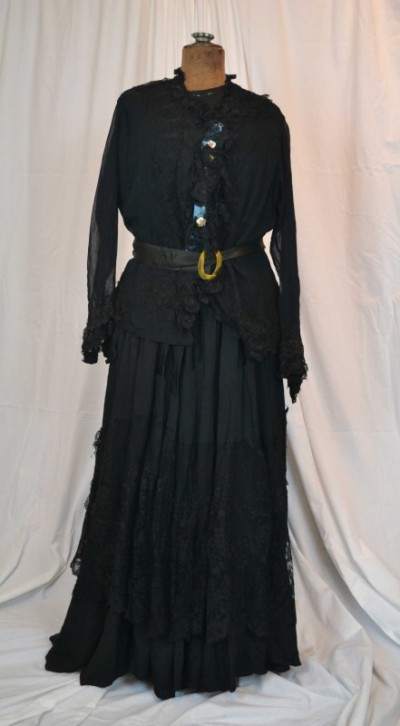
Maude Fidler Blackwell Epley was born just outside Salem in the little community of Roberts (think Roberts Crossing, the restaurant) in 1876. She wore this dress to celebrate her roots in the Salem area when the whole city celebrated its centennial in 1940. Her grandparents, Louis and Sarah Pettyjohn came by wagon train to Oregon 1847. The design of Maude’s dress echoes the styles worn by her grandmother Sarah Pettyjohn
Santiam Spree Queen, 1938
WHC 2015.054.0001
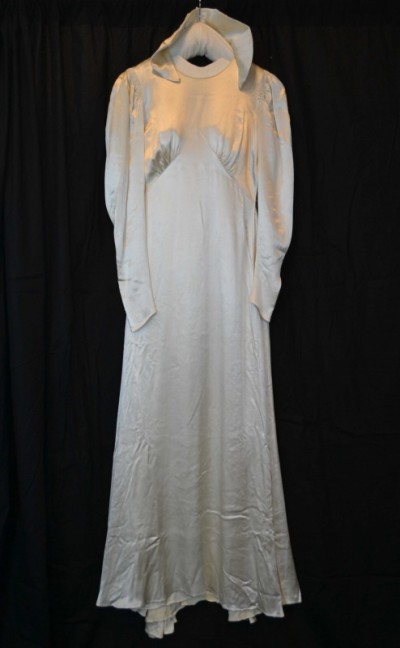
Margaret “Margie” Shields Kimbrough Pluemke wore this dress for her coronation as Santiam Spree Queen in 1938. Margie was a telephone operator that was elected Queen to represent the community in the four day celebration in Stayton. The dress was later used, without the collar, by Margie’s daughter for her own wedding.
Party Dress, c.1960
WHC 0999.057
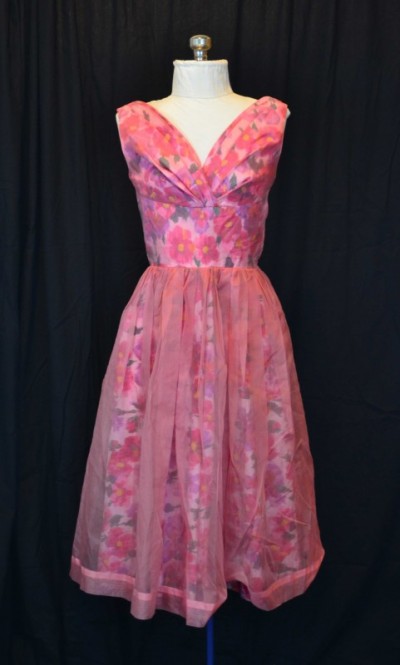
This dress was found in our collections. Somewhere along the way it lost its story. All we know is that it was made by the designer Sue Leslie of California.
Wedding Dress, 1916
WHC 2005.016.0001
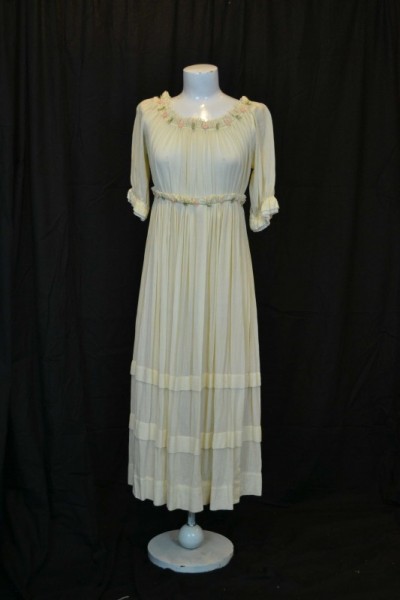
Lola Margaret Hall and John Palmer, Jr. grew up together in Marion, Oregon. This is the dress that she wore to their September wedding in Salem in 1916. John Palmer went on to work 23 years for the Children’s Home in Corvallis. Lola raised four children and worked at the Camp Adair Hospital and Post Office before succumbing to a heart attack at the age of 49.
Wedding Dress, 1899
WHC 2014.029.0001
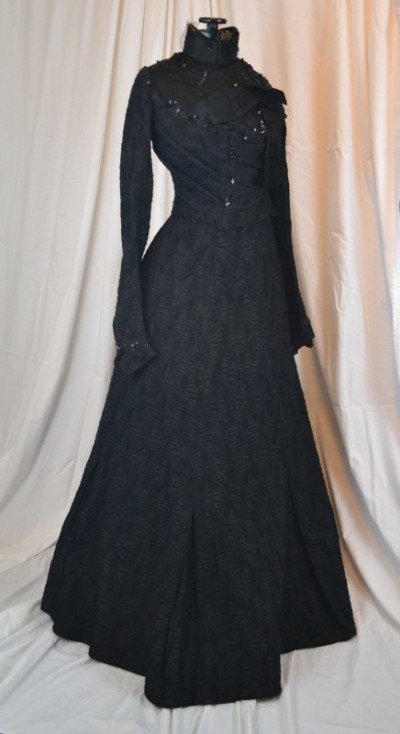
Fannie Rebecca Kehne wore this dress when she married Alonzo Theodore “Lon” Waln on October 10, 1899. The wedding was held at noon on a Tuesday at Fannie’s sister and brother-in-law’s farm in Dallas, Oregon. Lon was about 10 years Fanny’s senior and worked as a bookkeeper in Salem.
Blue Dress
WHC M3 2008-007-0001
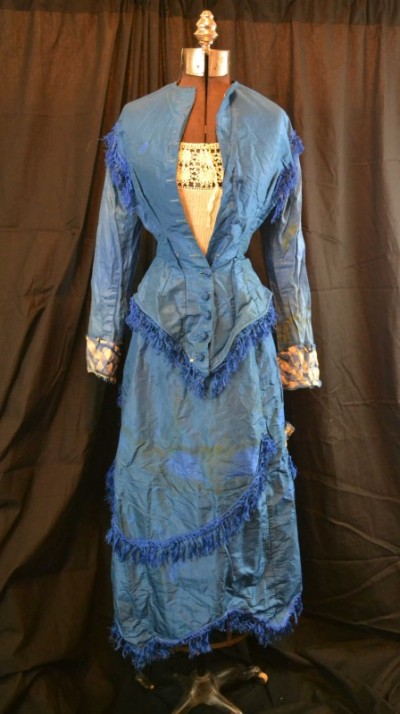
The story handed down with this dress was that it belonged to Sarah Alice Judson French (1887-1981), the grand-daughter of Missionary Lewis Hubbell Judson. If we assume that this is a dress for a teen-aged girl or adult, it would have to date to 1900 or later. The style of this dress, however, with its tight sleeves, long (cuirasse) bodice, and interesting drapery is more reminiscent of styles worn in the 1870s and 1880s. Could this have been a costume? Could this have belonged to an older family member?
Pink Child’s Dress, c. 1835
WHC M3 1993-002-0002
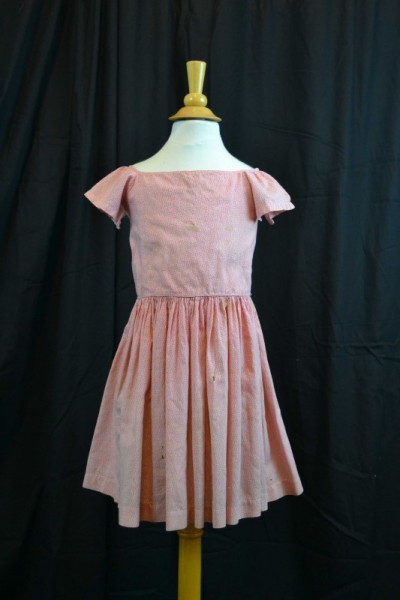
This dress was donated to the museum with materials from the Robert Stuart Wallace Family. Luckily, family stories identify this dress as belonging to Mary Wallace Park, Robert’s sister. Since we know Mary was born in 1830, we can guess that this dress dates between her birth in 1830 and about 1840.
Dress. Date Unknown
WHC 1984.069.0009
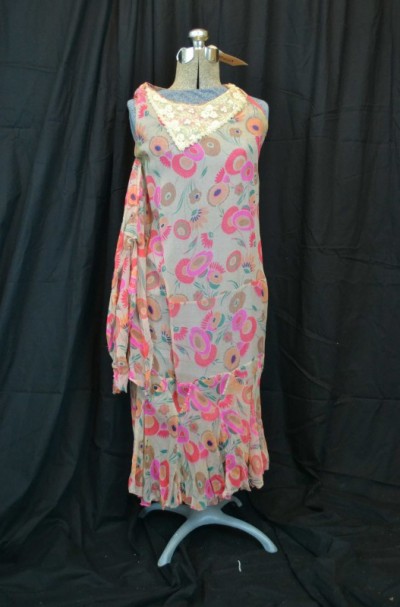
This is a short, chiffon dress with a Lace collar and orange and pink with flower design.
Wedding Dress. Date Unknown
WHC M3 1983-021-0001a
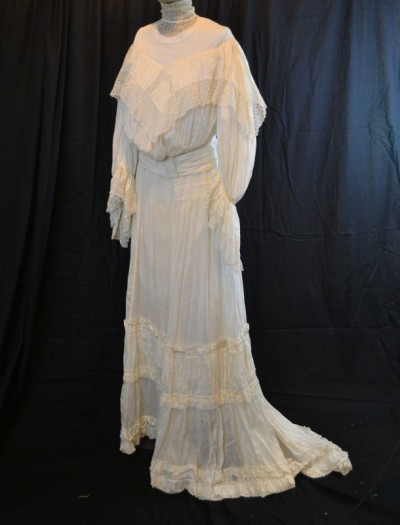
This is a white cotton wedding outfit. White only became a popular color for bride’s dresses after the wedding of Queen Victoria of England and Prince Albert where she wore an extravagant white wedding dress. Before that, there wasn’t a unified color in the west for brides.
Day Dress, c. 1870
M3 1993-002-0001
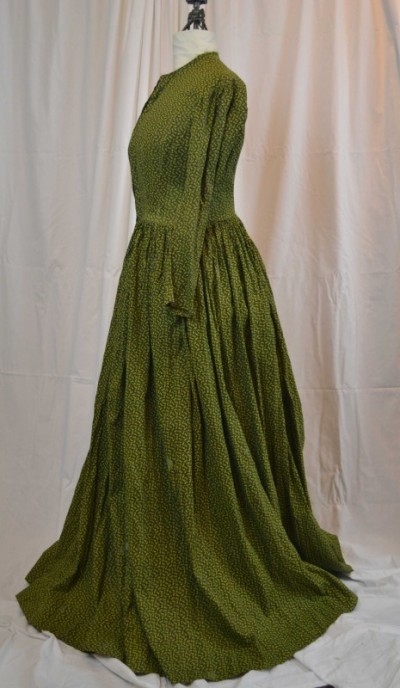
According to the donor, this dress may have belonged to Nancy Black Wallace (1845-1913). She was a founder of the Pi Beta Phi Sorority. Day dresses were typical of casual wear for women during this period.
Infant Dress and Smock, c. 1833
WHC M3 1988-005-0004
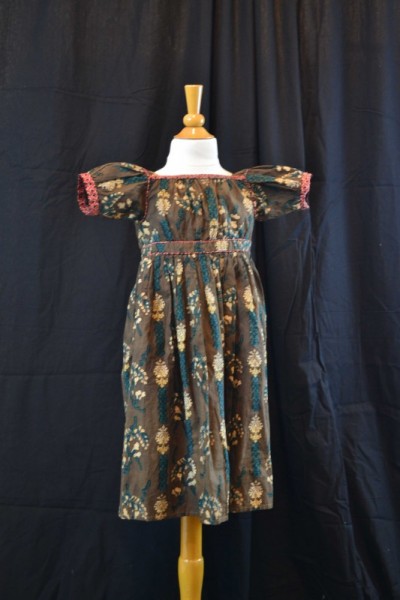
This dress belonged to David Hall Pugh (1833-1912), a well-known builder in the early Salem community. He built the Cook-Patton House. David’s son Walter followed in his father’s footsteps and became a prominent architect, designing the building you are standing in, Salem’s old City Hall and the Shelton-McMurphey house in Eugene among others.
Dresses were standard wear for both boys and girls through western history. A rite of passage, known as breeching, marked the time when boys wore their first pair of pants (breeches). This could happen between the ages of 2 and 8.
Dress, c. 1918
WHC 2014.029.0015
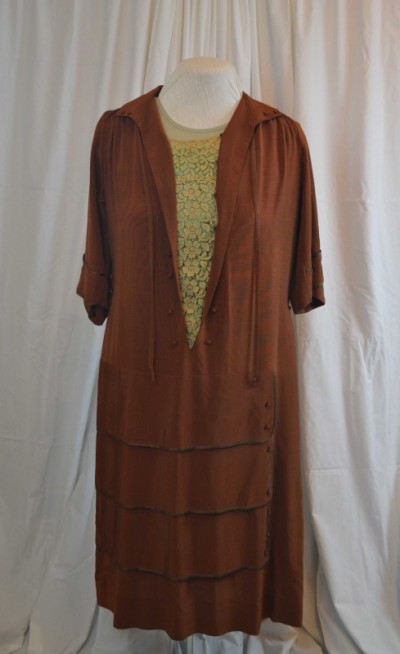
This dress is a brown day dress with a lace and sheer green chest cover. The flower lace used to be white but due to age, the fabric has yellowed.
Confirmation Dress, unknown
WHC 0999.060
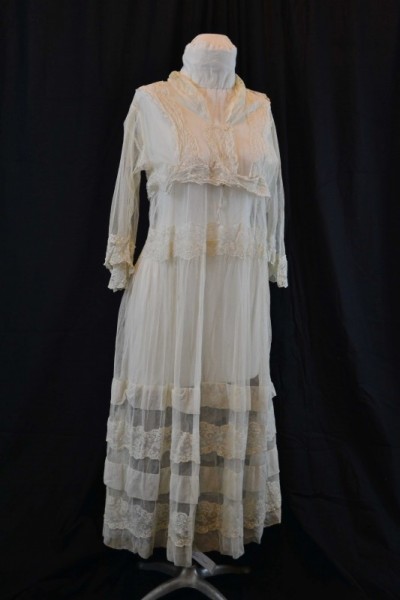
This dress was used in the christian ceremony of Confirmation. This is a ceremony that is used as a public declaration of children that have already been baptized that they will follow the church and the faith.
Christening Gown, 1854
WHC 2005.004.0001
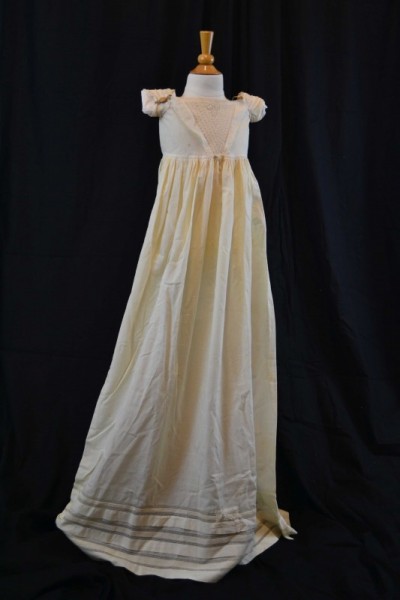
This gown was used at the christening of Joseph Robert Davidson (1854-1925). He was born to German Immigrants Sarah and Jacob Davidson who had made their way to Oregon. He and his family moved to California where he practiced medicine. There are metal epaulets on both sleeves. It is unclear if these were part of the dress or maybe bracelets worn by the baby that were later fastened to the sleeves.
Christening Gown, 1876
WHC M3 1994-007-0001
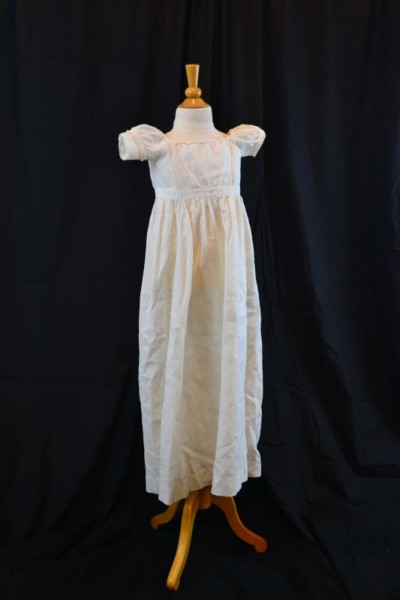
This gown was made for Effie Margaret Judson Card (1876-1932). She was the daughter of Robert Judson, and granddaughter of Lewis Hubbell Judson the missionary to Oregon and Judson Middle School’s namesake.
Gloves
WHC 0090.001.0041a, 0083.001.0006.001
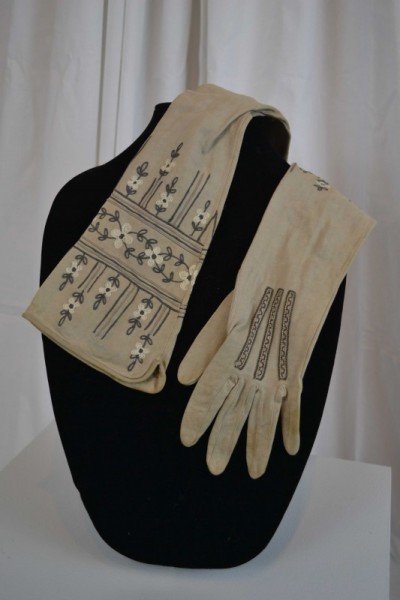
These are a pair of very long women’s gloves with flower decorations on the upper part. It has 3 snaps and a gray-brown color. The floral decors are silver, red, and green in color.
Gloves
WHC 0999.020a,b
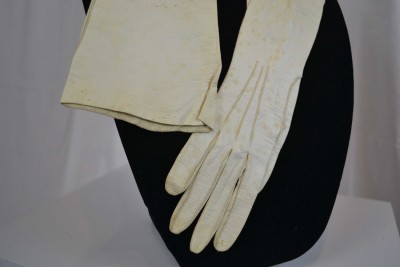
This pair of woman’s white long evening gloves are made of leather and have 3 small pearl buttons for fastening.
Gloves. Date unknown
WHC 1990.001.0041a,b
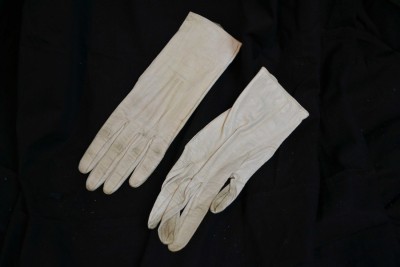
This is a pair of women’s short, white, leather gloves. They have snaps and covered buttons on the fasteners.
Gloves c. 1899
WHC 0081.023.0026.001
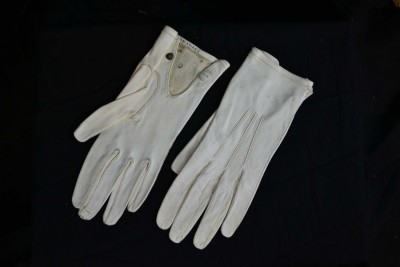
These are a pair of white leather gloves with a snap closure. These were made in France, 1899.
Gloves c.1960’s
WHC 0999.149a,b
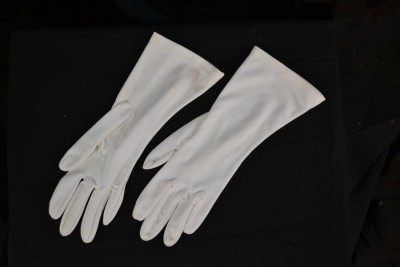
These are woman’s gloves that are made of a white nylon. Once nylon was discovered to be a viable material for clothing, it started to overtake the market and clothes made fully of natural materials were being replaced in homes.
Cap
WHC 0999.199
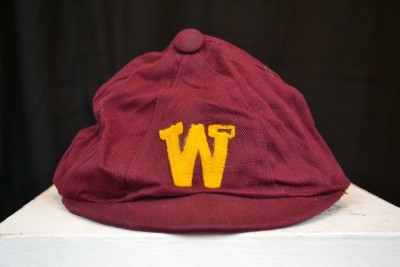
This dark red/maroon cap has a gold ‘W’ on the front of it. It is presumably a Willamette University Cap as it is the right colors.
Knights Templar Ceremonial Hat.
WHC 0999.658a
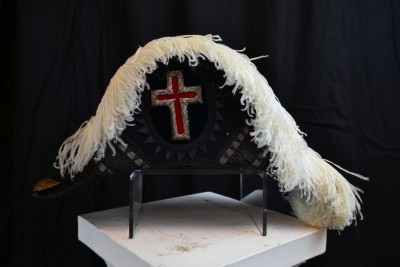
This is a fraternal hat with black silk over cardboard. It has a front and back bill with the sides folded up to crown on both sides. There is a silver coiled metallic braiding on the front bill. The white feather plumes over the crown from front to back. One side has a silver and red cross surrounded by decorative black braiding. Inside of hat is a label that says: Henderson Ames Co. — Military and Society Goods Kalamazoo, Michigan”.
The Freemasons are a secluded fraternal society which traces its origins to the local fraternities of stonemasons in the late 14th century. Their rituals and symbolism are directly related to masonry, such as the symbolic use of the trowel. There are many affiliated organizations deriving from the Freemasons that are usually centered around specific beliefs and rituals.
Cherrians Hat, c. 1913
WHC 0083.034.0007
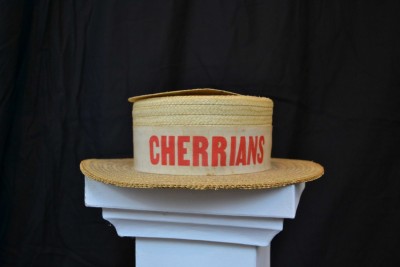
This hat belonged to charter Cherrians member Olaf A. Olson (1883-1967), a local dentist. The Cherrians organization served as unofficial ambassadors for the City of Salem. They marched in parades and organized events to bring attention to the area. The straw hat was a trademark of their uniform.
US Army Cap
WHC 2005.016.0007
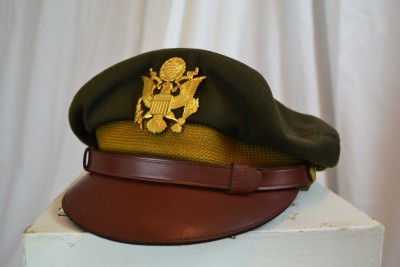
This is a US Army cap with dark green wool, with a leather trim and a leather bill. There is a brass eagle insignia on front and a brass button on each side. It was made by Daniel P. Adamson in Westwood Village, California.
Motor Sales Cap, 1940-1964
WHC 2014.082.0130
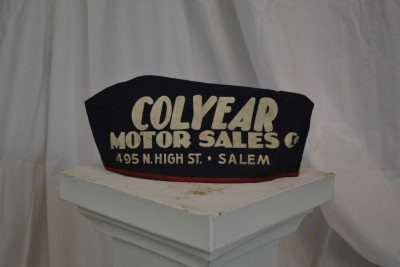
This is a Skull Cap hat with “Colyear Motor Sales Co. 495 N. High St. Salem” on one side and “Your NAPA Jobber is a Good Man to Know” on the other side. The hat is black with red tape on the edge and white lettering. Colyear Motor Sales was located at the N. High St address from 1940 through 1964.
Man’s Uniform Band Hat
WHC 1989.013.0002.003
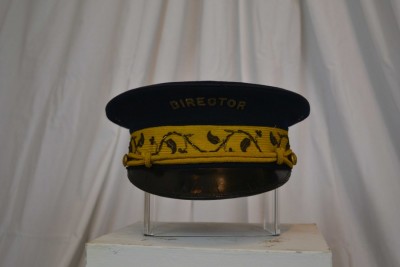
The cap above was used for “Cherry Bud Band”. It is navy blue with a gold band, a metallic floral trim, and a “Director” black brim. The band played at the Oregon State Fair each year and at the Rose Festival as well as the Cherrian event in Salem, during the 1920’s.
Baby Bonnet, 1913
WHC 0083.040.0002
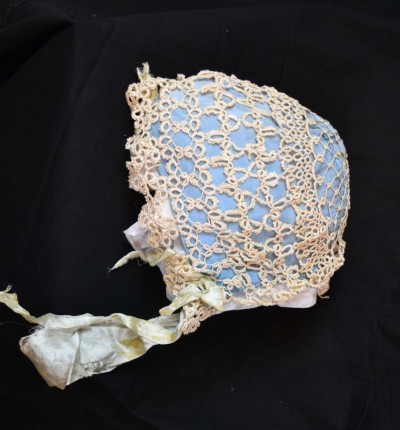
While there are documented examples of blue and pink being used to identify male and female children in a hospital as early as 1869, the large scale differentiation of boys and girls clothing by color in American clothing is a post WWII phenomenon. Trade catalogs from as late as 1918 suggest pink for boys and blue for girls. Red was considered a masculine color and pink, the diminutive form, appropriate for young men. Blue was thought of as dainty. Bernice, Irene Fink’s mother must have bought into this ideology as this bonnet (displayed) and her baby booties (not displayed) were decidedly blue.
Cap
WHC 1989.023.0006
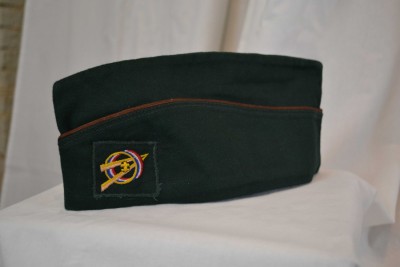
This is a Boy Scout Uniform Garrison cap. It is a dark green uniform cap with an EXPLORER emblem on one side and a brown thread trim. Inside the cap is: “Sanforized — Large — 7-7 1/8 — Price $ 1.00 — Name: _____________” Label, “Boy Scouts of American Official Cap…”
Camp Fire Girls Cap
WHC 0099.032.0001
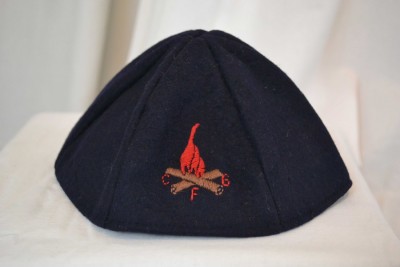
The Camp Fire Girls of America was the first nonsectarian, multicultural organization for girls. Just like its “brother” organization, the Boy Scouts of America, it emphasized camping and outdoor education. Today, the organization has changed their name to Camp Fire with membership open to both girls and boys.
Nurse Head Scarf
WHC 0999.666
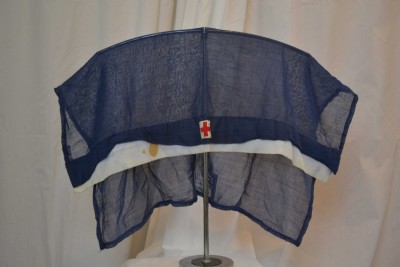
This is a dark blue cotton head scarf form American Red Cross Nurse’s uniform. There is a white band across front and arc cross in red on white sewn front center. This was used by Red Cross nurses as a part of their uniform.
Day Cap, c. 1850
WHC M3 1981-015-0007
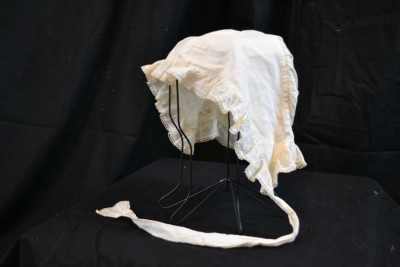
Women in the early 19th century often kept their hair covered this certain hats like the bonnet above. This would be used mainly indoors and hats with a wider brim were more common outside to avoid getting freckles.
Al Kader Fez Cap
WHC 1988.020.0006a
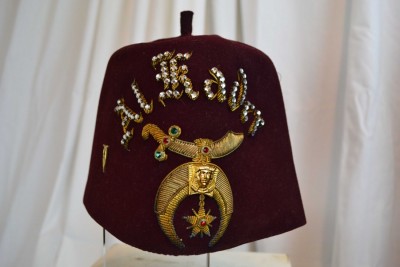
The Ancient Order of the Nobles of the Mystic Shrine was founded by thirteen Freemasons, which has led to over 300,000 members and 196 Shrine Centers. The Shriners are a community-oriented fraternal organization with Shriner hospitals all around the United States, dedicated to helping children. The Al Kader Shriners is the name of the Portland, Oregon chapter.
Fraternal Cap with Case
WHC 1988.020.0005a,b
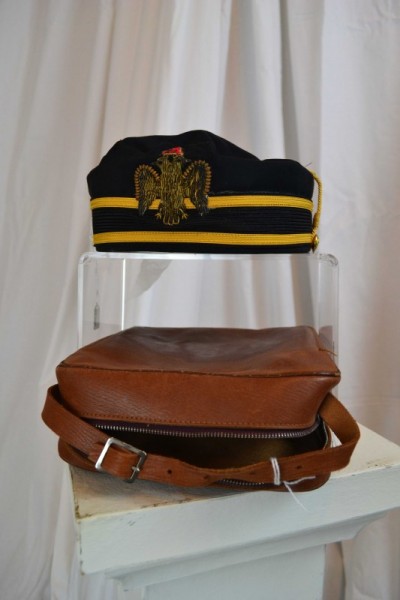
This is a round black cloth hat with gold piping and braiding, no brim, and a metallic coiled emblem on front in shape of back to back eagles with a “3” within a red triangle. There is a Leather inner headband and a gold colored button attached on both sides of cap. the name “KENNETH J. GOLUET” is stitched in gold thread on inside of cap. This hat is properly a 32nd degree Masonic/Shriner cap.
Hat
WHC 0080.001.0007.001
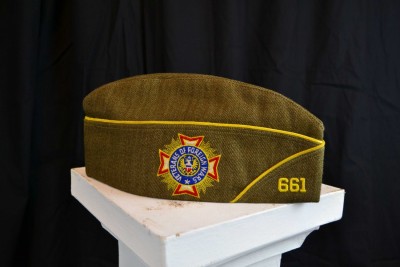
This Khaki green hat with gold braid has a VETERANS OF FOREIGN WARS symbol on one side and 661 OREGON. It is a Size 7 1/8 and was used as a part of a uniform.
Hat, American Legion. c. 1932
WHC 0085.028.0013
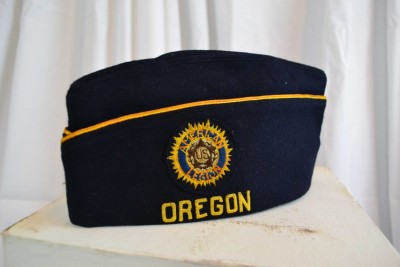
This hat is dark blue with gold trim and shows the emblem of the American Legion on one side with the number 9 on the other. Owned by John Kovarik (1891-1985), Veteran of World War I.
“The American Legion was chartered and incorporated by Congress in 1919 as a patriotic veterans organization devoted to mutual helpfulness. It is the nation’s largest wartime veterans service organization, committed to mentoring youth and sponsorship of wholesome programs in our communities, advocating patriotism and honor, promoting strong national security, and continued devotion to our fellow service members and veterans.” -The American Legion Mission.
Chinese Hat, unknown
WHC 0084.072.0001a
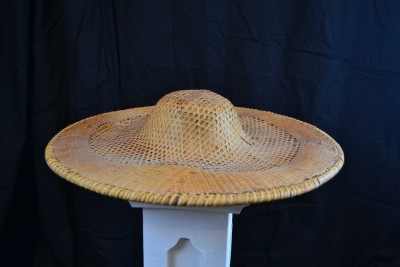
This hat’s donor called it a “Chinese worker’s hat.” Beyond that, its history is a mystery.
Hard Hat
WHC M3 1991-200-0849
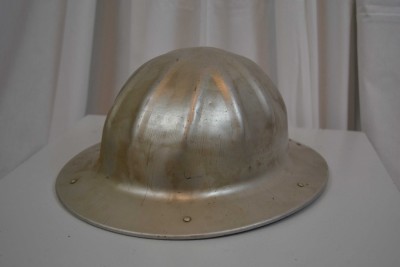
This hard hat belonged to the Thomas Kay Woolen Mill’s long-time millwright, Wayne Mentzer (1904-1984). It would have protected his head from the machinery while he was doing his job.
Hat, c. 1955
WHC 2012.086.0001
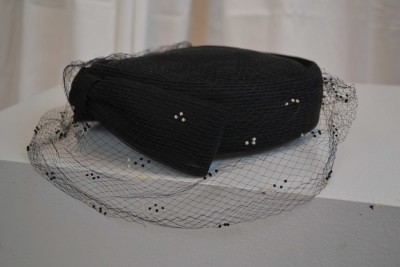
The hat above was made by a company in New York City for exclusive sale at Meier & Frank Stores. This hat was owned by Edith Elizabeth Jennings Jones, who was a long time employee at Sally’s Dress Shop in Salem.
Derby, c. 1920
WHC 0094.076.0003
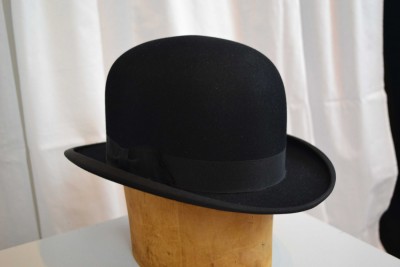
This derby belonged to Louis Lachmund, a fruit and hops grower turned mayor and state legislator. This type of hat is also called a bowler, which is more common in Great Britain.
Motoring type hat.
WHC 0063.001.0021.020
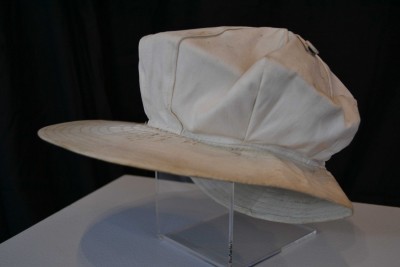
This driving hat is white and all cloth with 2 buttons & a strap on top. Inside the hat is “OUR STANDARD” and ‘6 1/2″‘. There is a brim across front. In the early days of driving, it was common to wear thing like driving hats, gloves, goggles, and coats in order to keep yourself clean from the car and the rushing wind.
Cap
WHC 0081.023.0026.002
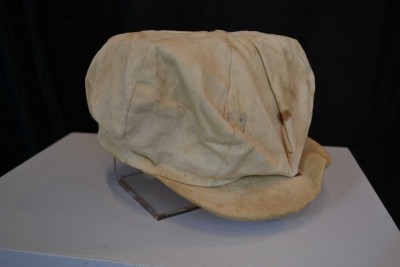
This motoring cap is made of white cloth with metal snaps & buttons.
Night Cap
WHC M3 1978-012-0005
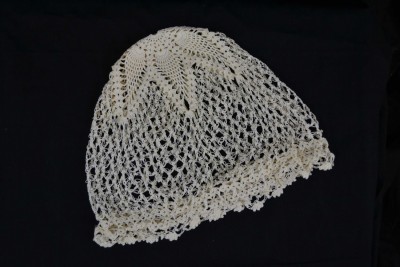
This cap was used by women during the night time to keep their hair in place as they slept.
Women’s hat c. 1950s-1960s
WHC 0999.189
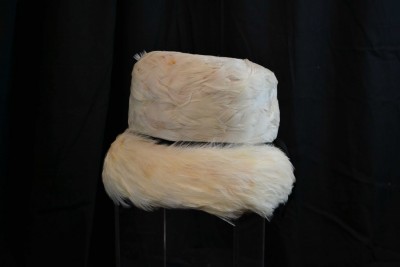
This is a women’s cloche hat with white feathers and black velvet ribbon. There is a label that says: “Union Made AM 953564 in USA”
Woman’s Hat
WHC 0999.181
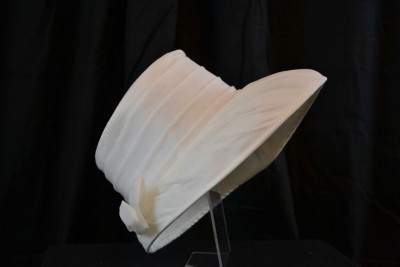
This is a women’s hat of white rayon crepe over a white base and a bow in the back. The label reads “union made Go 820044 in USA”
Turban Hat
WHC 0082.007.0033.006
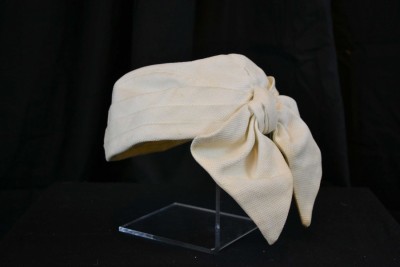
This is a turban-styled white hat with very large ribbon in the back.
Nurse Cap. c. 1918
WHC 1990.001.0037
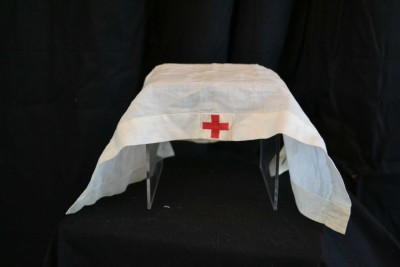
This is a white cotton lawn, with the Red Cross sown on front. It is a scarf style that buttons in back. This was worn by nurse’s aides in World War I.
Tie Rack
WHC 1989.023.0021
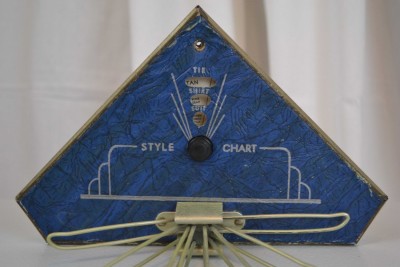
This is a tie rack with coordinating “color — style chart ” for Boy Scouts of America uniforms. The tie holders move out to hold 8 ties.
Clothing Brush
WHC 2014.082.0649
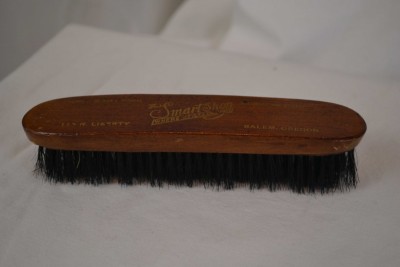
Think of it as the 19th century equivalent of dry cleaning. Many folks brushed dirt and other debris from their clothing. In a community like Salem with few paved streets, dirt was a much more common issue. However, if you were patient, you could wait until the mud dried and then brush off the remains.
Wool Patch
WHC 1990.001.0039
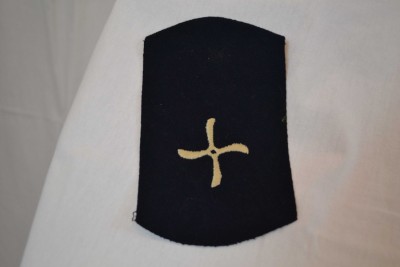
This is a navy blue wool patch with white embroidered propellers design was originally from a Navy uniform.
Junior/Senior Prom Dance Card, 1938
WHC 2014.082.0642
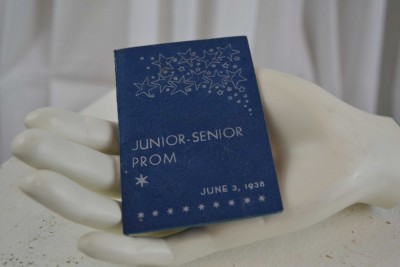
This card was worn on the wrist. Cards like these helped women keep track of who had reserved which dance. This card has spaces for 14 dance partners to be filled in. Music that night was provided by Jack Shepard’s Orchestra.
Triangle Flag
WHC 2014.082.0131
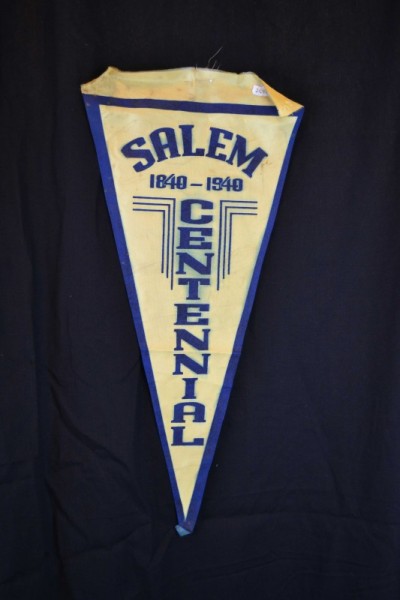
This is a 19 x 9″ triangle flag for Salem Centennial 1840 – 1940. It has a Yellow background and navy blue lettering and has “SALEM” at the top, the dates and ‘CENTENNIAL” in a vertical position.
Spurs, c. 1918
WHC 0087.035.0029
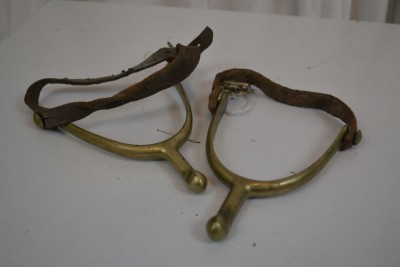
These were used by Dr. W. Carlton Smith during WWI. He was a medical officer attached to a cavalry regiment
Fur Muff
WHC 2013.002.0001
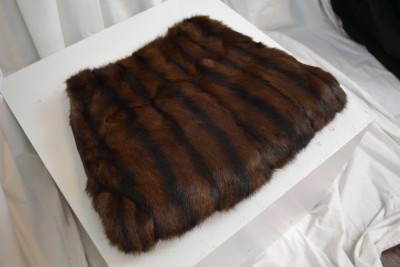
This belonged to Dorthea Aspinwall of Salem. This was used to keep women’s hands warm and were used as a fashion statement.
Old Believer’s Belt
WHC 2009.020.0003
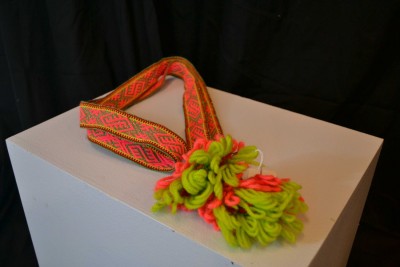
The Russian Old Believers formed after refusing to accept Russian Orthodox Church reforms enacted in 1654. Escaping the pressure of communism in Russia and surrounding countries, a group of Old Believers fled to Woodburn, Oregon in the 1950s to establish the communities currently present there. While their daily dress is a very modest and conservative style, their traditional costumes, such as the ones on display, are very vibrant.
Mill Gear
WHC 2009.088
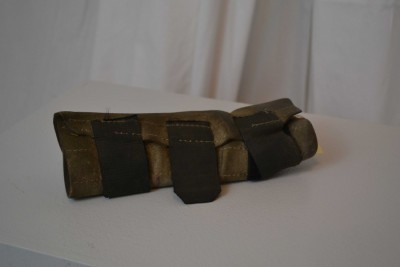
The gear in the case below belonged to Jacob Neufeld (1919-2005). He worked at the plywood mill in Valsetz for 42 years; up until two months before its closing in 1984. His spiked, caulk (pronounced cork) boots and leather wrist guard and apron would have protected him from the mill machinery.
Shoe Stretcher?
WHC 0063.001.0002.038
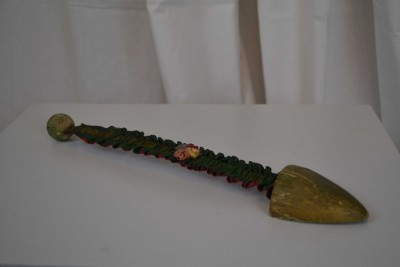
This item was labelled as a shoe stretcher in our records? Does that seem reasonable to you?
Buttons
WHC 0063.001.0006
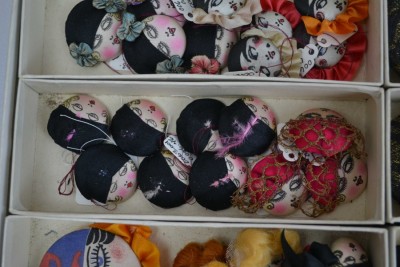
This is a collection of woman’s face button with silk hat and two clear jewel accent buttons. It is made of ribbon, silk, and other materials used as decorative “buttons” on dresses and other garments. Probably store inventory from Renska Swart’s shop.
Hair Bracelet
WHC 0084.045.0016
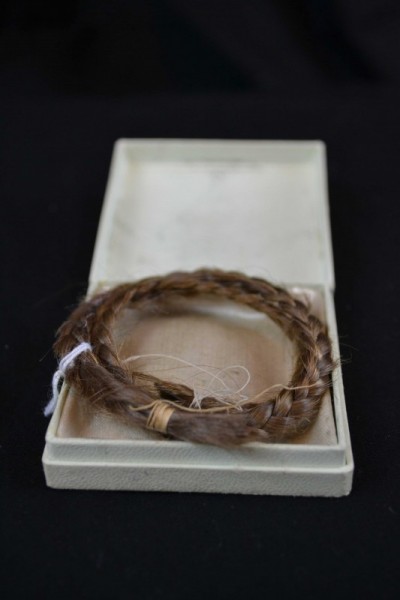
Making rings and bracelets out of a loved one’s hair is an old tradition. While this looks like a braid of hair, many pieces are so intricately woven or artfully set in metal bands that it is sometimes hard to tell.
Tie Pins
WHC 0084.045
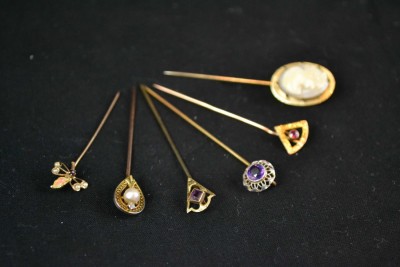
Tie pins were remnants of devices used to hold complex cravats fashionable in the early 19th century.
Button Hooks
WHC 0063.001.0021.019
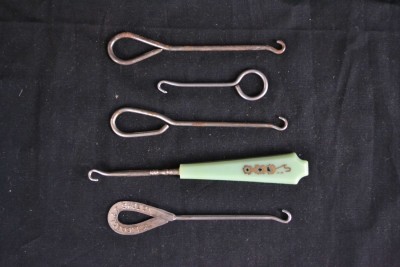
These were handy for people who needed help with fastening their buttons.
Mink fur collar
WHC M3 1976-026-0017
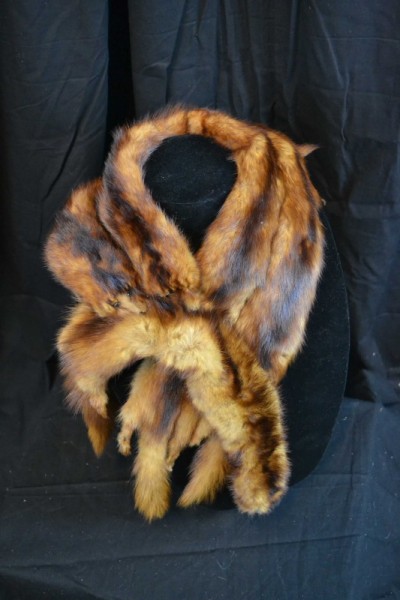
This is a collection of 5 pelts, with the front closing with metal clamp. The clamp is covered in dark brown crochet. Each pelt is complete, closing in front. There is cotton batting in each pelt.
Lace collar
WHC 0076.060.0011
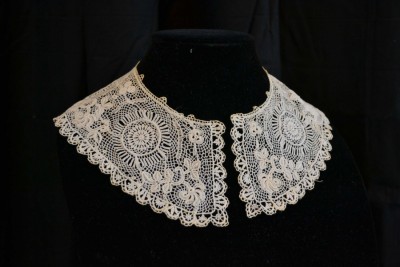
This is a crocheted collar with a design of circles and flowers.
White Linen Collar
WHC 0076.060.0007
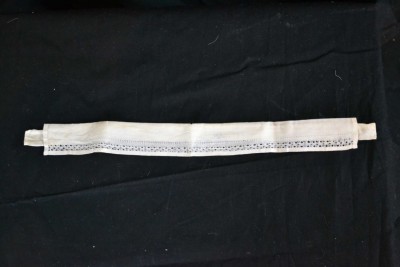
This is a collar with a “Pulled” lace edge.
White Cuffs
WHC 0999.115a,b
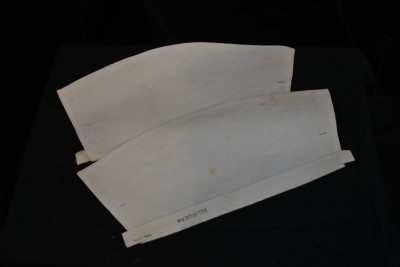
This is a pair of white starched cuffs, possibly part of nurse uniform. Each of them is stamped with “Belvidera”.
Boy Scout Uniform belt
WHC 1989.023.0011
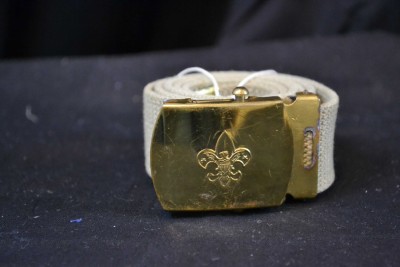
This is a rigger style belt. It is a cotton canvas, web belt with brass buckle. The buckle has B.S.A. emblem on front.
Pinning Blanket c. 1900
WHC M3 1979-012-0012
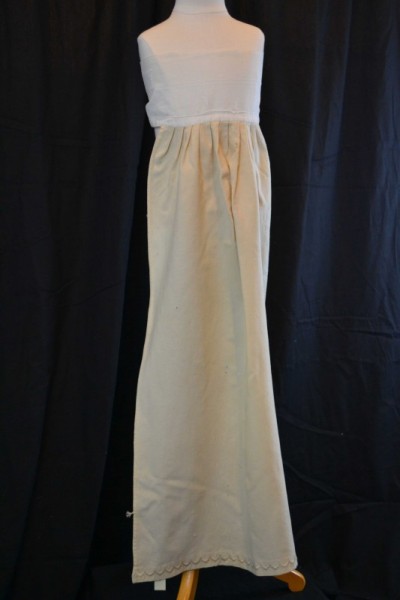
We had to look it up, too. A pinning blanket was pinned around the baby’s waist forming another layer against the elements. It was open at the back to allow easy diaper access.
Patches
Army Patch c. 1918
WHC 0085.028.0027
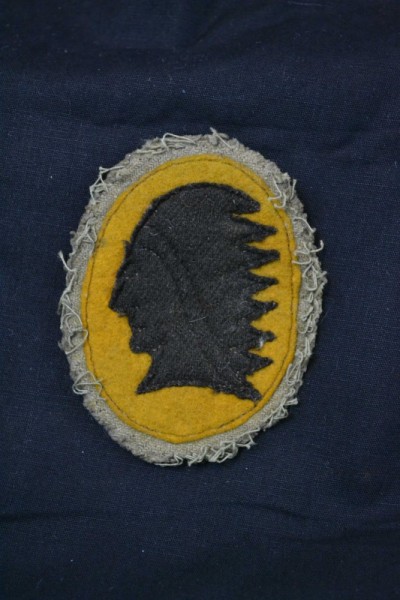
This is an oval army patch for the 8th Infantry Division. It has Khaki, dirty gold and black colors. It is pictured with a Silhouette of an Indian man wearing a feathered headdress.
Patch c. 1932
WHC 2009.080.0008
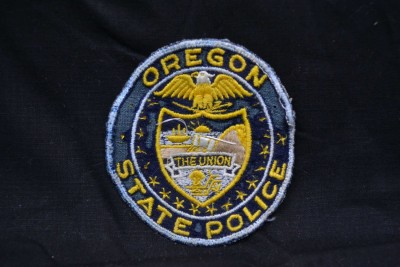
This is a cloth arm patch titled Oregon State Police with an eagle likeness and Capitol building likeness.
Badge
WHC 2014.082.0012.060
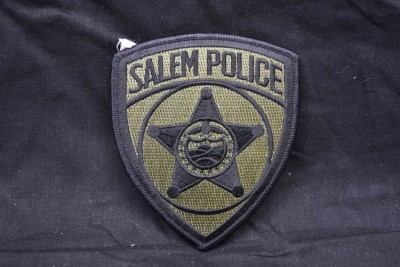
This is a cloth badge for the Salem Police Black on Green background. “Salem Police” is stitched across the top and below that is a circle with a star. Inside the star is a circle with tiny stars and hills and sun. The badge is in the shape of a shield.
Pendants
Pendant c. 1914
WHC 0081.023.0008.013.01
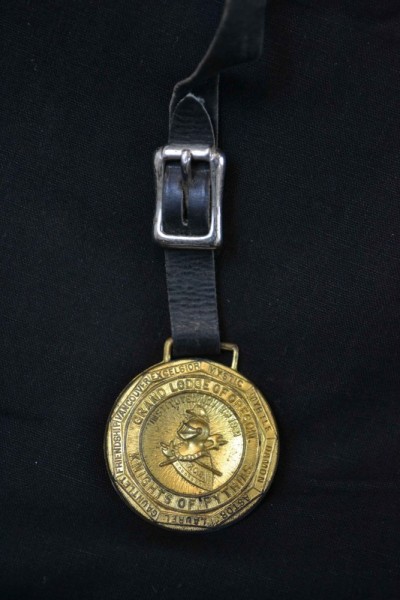
This is a medal that says Grand Lodge of Oregon, Knights of Pythias Instituted Nov. 8 1881. The front shows a knights armor and shield.
Pendant
WHC 0084.045.0013.001
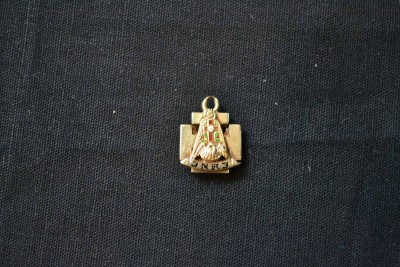
This is a charm or lavaliere. It is pictured with a silver double headed eagle and a Red enamel background and Gold base.
Pins
Pinback
WHC 0999.425.0001
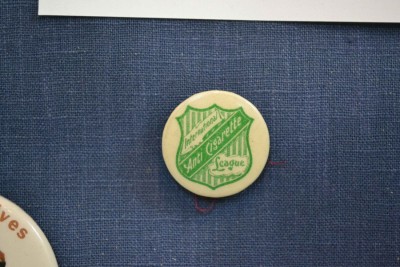
This is a round pinback with an off-white top with green shield that reads: “International Anti-Cigarette League”. The paper label on backside reads: “Pacific Regalia Company Makers, Portland Oregon.
Button
WHC 0999.448
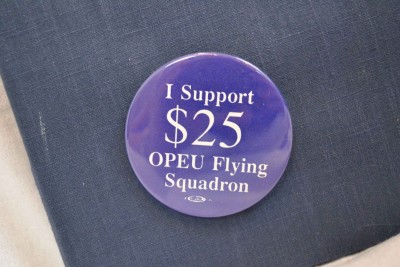
This is a round button. It has a blue top with white lettering that reads: “I support/ $25/ OPEU Flying/ Squadron”.
Button Pinback c. 1998
WHC 2001.004.0001
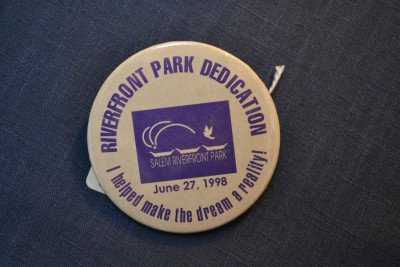
This is a round button pinback that says “Riverfront Park Dedication — (LOGO) — June 27, 1998 — I Helped Make The Dream A Reality.” It has a purple on white background front.
Button c. 1900-1920
WHC 2012.001.0001
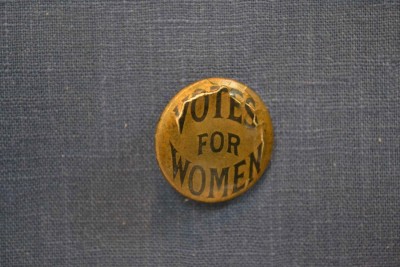
One small round button with open stick attachment device on back. This is gold colored with black printed writing that reads: “Votes for Women”.
Button
WHC 2012.004.0004
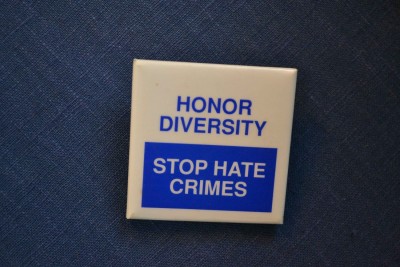
This is a white and blue buttons with “Honor Diversity Stop Hate Crime”.
Button c. 1987
WHC 2012.004.0008
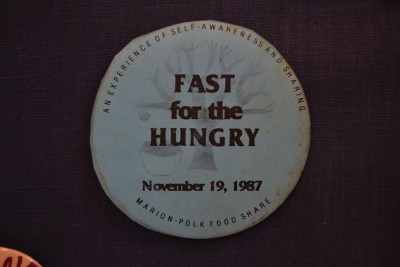
This blue button says “Fast for the Hungry” (an experience of self-awareness and sharing) Marion-Polk Food Share.
Button
WHC 2012.004.0009
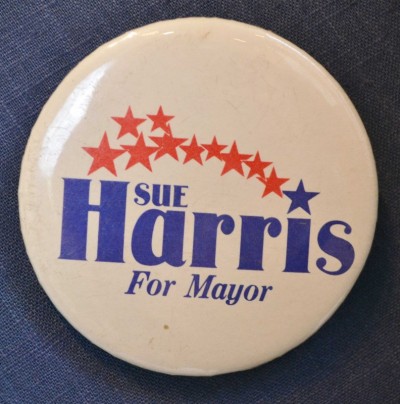
This white button is campaigning for “Sue Harris for Mayor” and has red stars decorated on it.
Button c. 1970
WHC 2012.004.0025
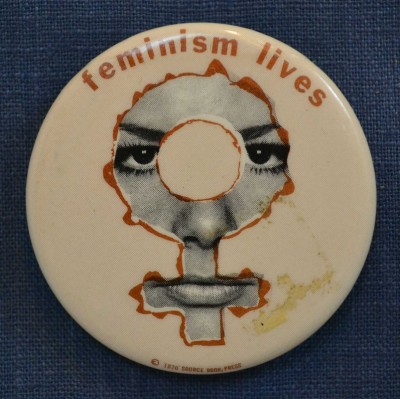
This white button says “Feminism Lives”.
Button
WHC 2012.004.0027
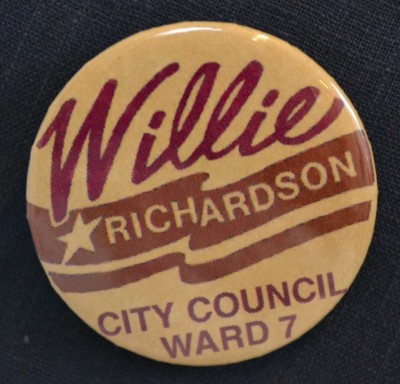
This tan button with brown letters says “Willie Richardson City Council Ward 7”.
Button c.1990
WHC 2012.004.0034
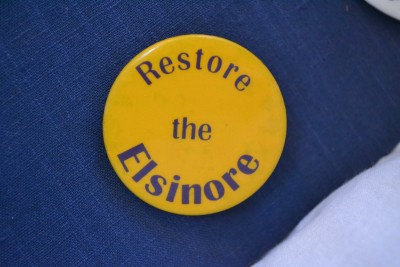
This yellow button with black letters was used to raise awareness to “Restore the Elsinore”.
Button
WHC 2012.004.0040
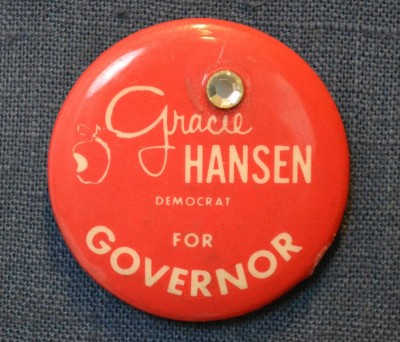
This red button with white letters is campaigning for “Gracie Hansen Democrat for Governor”.
Ceramic pin c. 1977-1989
WHC 2014.037.0001
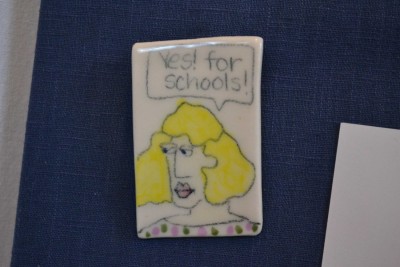
This is a rectangular ceramic pin with an illustration of a woman with blond hair and a green and pink polka dot shirt with a voice bubble with the words “Yes! for schools!”.
City Transit Lines Badge
WHC 1995.015.0004
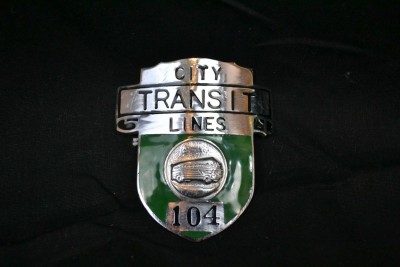
This pin is silver colored and shield shaped. There are two screw-on fastener posts on back side with a round emblem of a bus in relief on the front set in a green enameled surface. The words “City — Transit — Lines — 104” are printed in black letters. “Providence, Rhode Island” is on back. This belonged to Pryor Robertson, a Salem street car driver and later a bus driver.
Pin
WHC 0088.022.0005
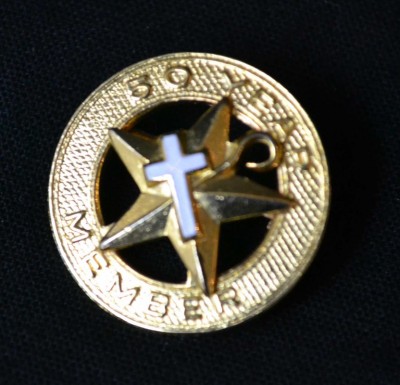
This is a round, gold colored metal pin with a cut-out around a 5 pointed star. There is a white cross in the middle of star. “50 YEAR — MEMBER” is written around the pin. The pin is clasped on back side. This pin was awarded to Merel Ramp, Mother of the donor, for her 50 year membership in Eastern Star. She joined September 13, 1921.
Pin c.1940
WHC 1989.027.0003
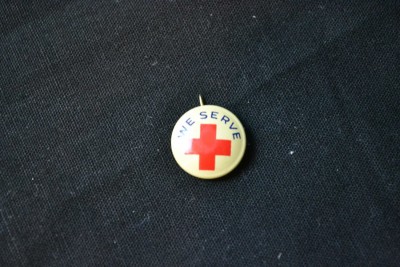
This is a round pin used by the Junior Red Cross. It is white with a Red Cross and “We Serve” written in blue above the cross.
Street Railway Badge
WHC 1995.015.0001
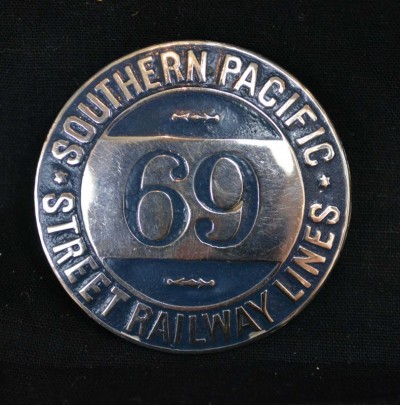
This is a round, metal pin with a clasp on back side. It is silver colored with gray on the front. The front of the badge reads: “Southern Pacific — Street Railway Lines – 69.” This belonged to Pryor Robertson, A Salem street car driver and later a bus driver.
White Button and Ribbon. C. 1965
WHC 1987.045.0008
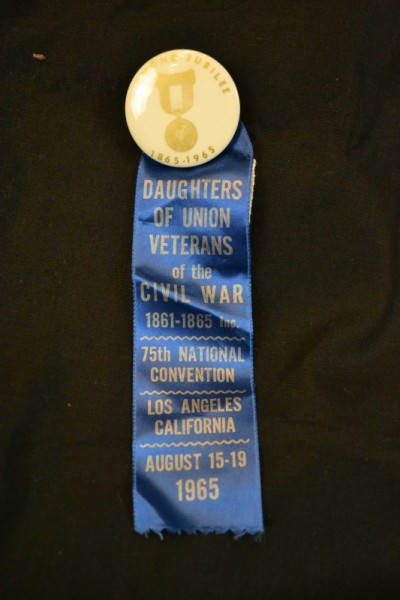
This stickpin has a blue ribbon with “Daughters of Union Veterans of the Civil War 1861 – 1865 Inc.” “75th National Convention Los Angeles California, August 15 – 19, 1965” on the ribbon with the lettering in silver. The button has “DIAMOND JUBILEE” in gold lettering. “1865-1965” with a picture of a medal in gold.
GAR Pin and medal in original envelope. C. 1924
WHC 1987.045.0013
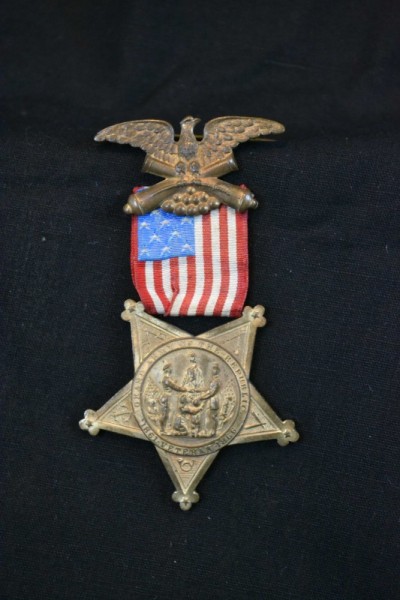
This pin has an Eagle on top, with U. S. Flag and 5 pointed metal star. There is an inscription that says “GRAND ARMY OF THE REPUBLIC — 1861 VETERAN 1866. Envelope – “Grand Army Badge — Of Captured Cannon Metal” Description by J. H. Golding, Adjutant General.
Pin
WHC 2005.042.0001
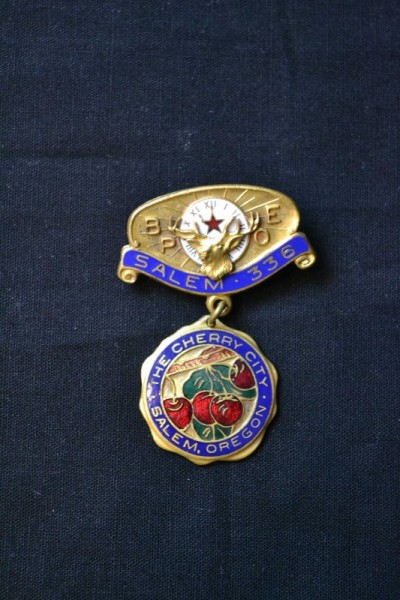
This pin is for the Salem Elks Lodge 336. This pin came from the Lester Anderson Estate, and may be from the Cornelius S. Idarton Family of Eugene.
Badge
WHC 2007.042.0001
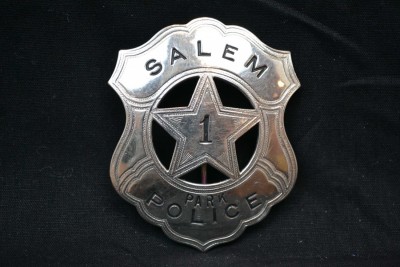
This badge belonged to Cleveland Shields who was the Parks Superintendent for the City of Salem. It reads: “Salem 1 Park Police”.
Badge
WHC 2013.003.0006
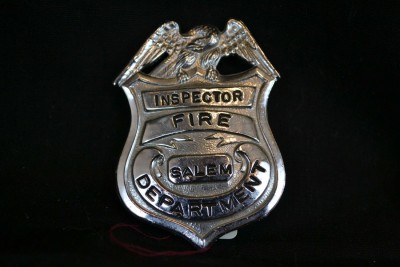
This is a Salem fire department fire inspector badge/shield.
Oval button c. 1948
WHC 2014.082.0107
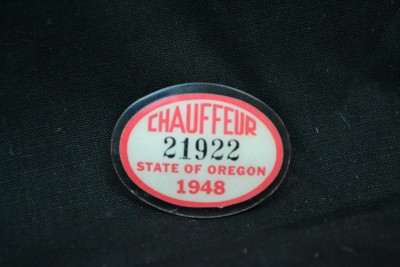
This pin is plastic with a pin backing. It was issued by the State of Oregon 1948 for a Chauffeur. The pin has the number 21922 on it, most likely the chauffeur’s number.
Badge c. 1953
WHC 2014.082.0639
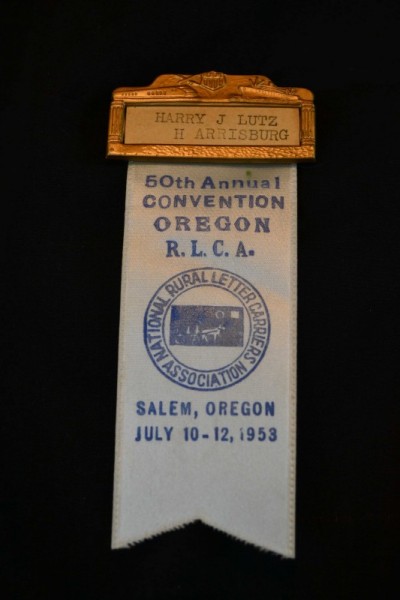
This is a badge for Harry J. Lutz from Harrisburg. His name is printed on paper at top of badge. There is a white ribbon hangs below and has, printed in blue with an insignia, “50th Annual Convention of Oregon R.L.C. A. (Rural Letter Carriers Association) Salem, Oregon July 10-12, 1953”.
Yellow -orange ribbon with metal badge. C. 1967
WHC 2014.082.0656
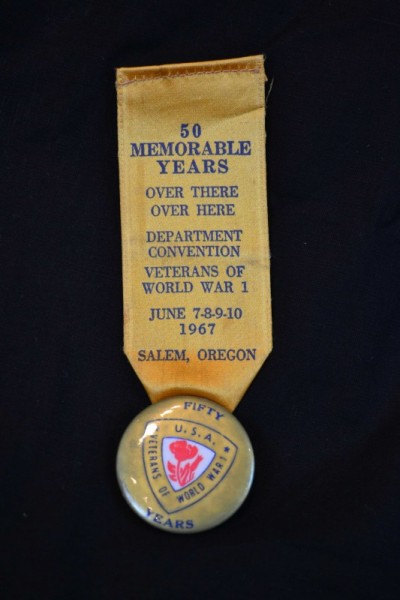
This pin has a ribbon with blue lettering that reads: “50 Memorable Years, Over There, Over Here, Department Convention, Veterans of World War I June 7, 8,9,10, 1967, Salem, Oregon”. It is gold colored, with a round metal badge attached to the bottom and has a red outline of a poppy in the center and blue lettering around a shield that reads “50 Years, Veterans of WWI, U.S.A”.
Pin c. 1898-1902
WHC 0080.001.0002.004
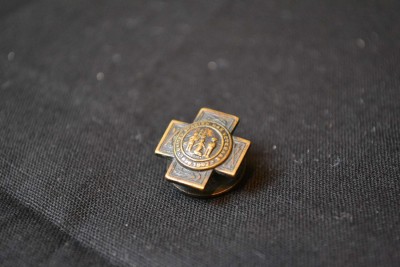
This is a small cross shaped pin with “UNITED SPANISH WAR VETERANS, 1898 – 1902” written on it. This is a brass lapel button with swords and various weapons on the edge of the cross.
Button
WHC 0080.001.0002.007
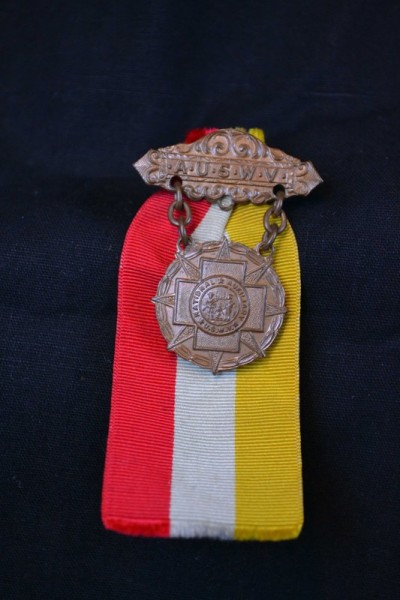
This was made with brass with a red, white, and yellow ribbon on the back. The lettering “A. U. S. W. V. national auxiliary U. S. W. V. W. & H. CO. NEWARK, N.J.” is on back
This pin did not come with provenance information. However, since many of the other materials in this collection can be connected to Rudolph A. Horn (donor’s father) it is not too much of a stretch to assume that this pin may also have belonged to him. The application for a military headstone for his grave in the City View Cemetery lists an enlistment date for Horn as 10/23/1901, making him involved in the US Military during the time of the Spanish American War. Auxiliary groups tended to be non-veteran, but children and women of veterans. It is possible this button belonged to Johnnie Neal Ward Horn, wife of Rudolph A. Horn.
Metal Button
WHC 0080.001.0002.002
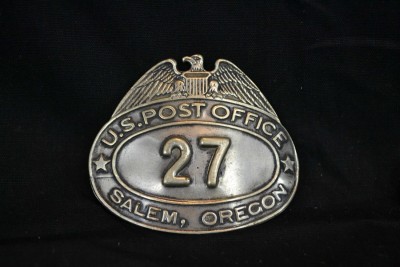
“U.S. POST OFFICE SALEM, OREGON 27, on back, N.C. WALTER 7 SONS, NEW YORK” is written on the oval shaped metal button with a eagle on the top and is silver in color.
Fraternal pin
WHC 0084.045.0008b
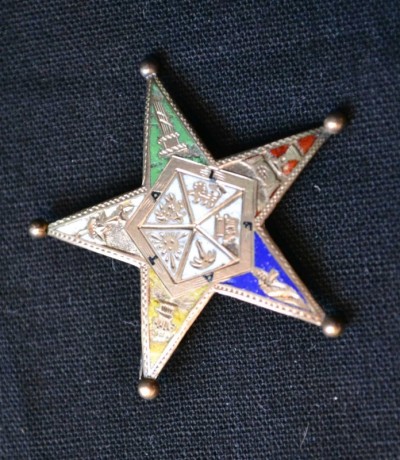
This enameled star-shaped pin with Order of Eastern Star motifs. It is covered with Blue, Red, Green, Yellow and White enamel on brass colored metal. Each lobe of the star has a round metal ball at point. Each arm is a separate color with a separate motif. The center has a pentagram separated into five sections, each with their own image and with the letters FATAL inscribed on each side in black.
Button c. 1975-1985
X2011.009.0006
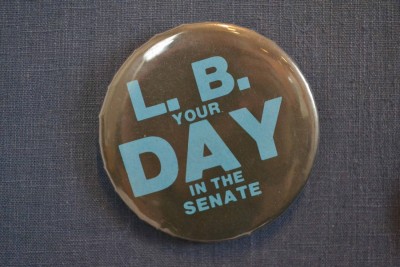
This button is ~2-inch diameter with a black background and light blue letters that say: “L. B Your DAY in the Senate”. There is a white adhesive label on the back with black printing that reads: “Produced by North Salem High School DECA Salem, Oregon, 97301”.
Button or tag
WHC 0999.427.0001
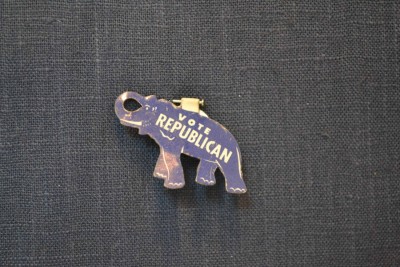
This thin metal tag, or button, with a blue elephant. Says: “Vote Republican”.
Button
WHC 0063.001.0006.038
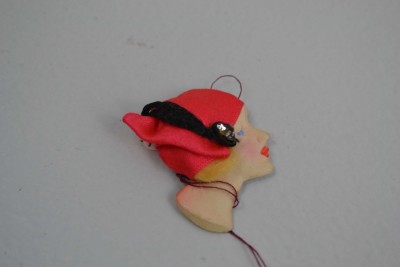
This is a woman’s face button with a 1920’s style with dark pink hat. It is made of ribbon, silk, and other materials used as decorative “buttons” on dresses and other garments. These are new items. Probably store inventory from Renska Swart’s shop.
Pinback
WHC 0999.424
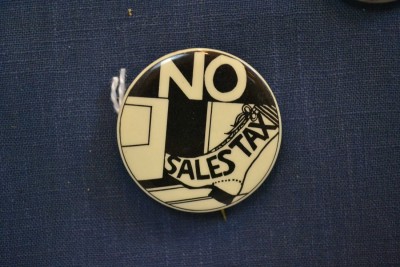
This round pinback says: “No Sales Tax” with an image of a high-topped shoe in black and white. “No Sales Tax League 2515 10th Ave, Milwaukie Oregon” is written on edge.
Button
x2011.009.0004
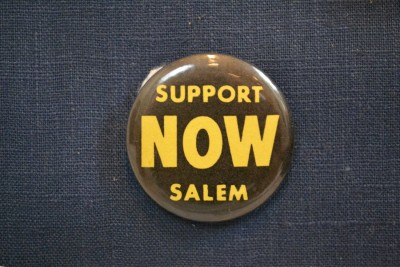
This button is ~1 inch diameter with a black background and yellow letters; Top: “Support”, Middle “NOW”, Bottom “Salem”.
Small Red Button
x2011.009.0010
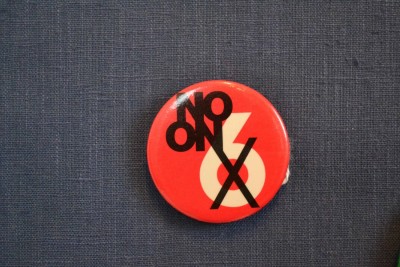
This button has a white six with a black x over it. One leg of x forms bottom of second N for “No On”.
Button
X2011.009.0016
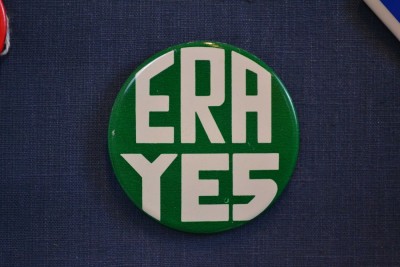
This button has a green background with large white lettering over whole face “ERA YES”.
Pin c. 1952-1956
X2011.009.0022
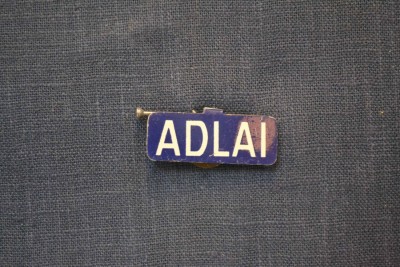
This is a blue lapel pin with white letters that say “Adlai”.
Button
X2011.009.0031
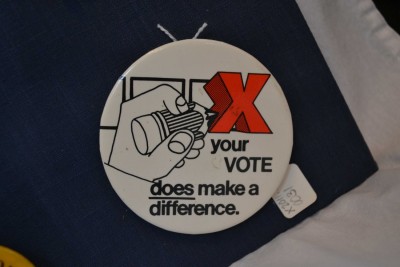
This white button has a large red x in upper right corner. In black, a stylized hand holds a pencil over three squares, and in the bottom half, it says “Your Vote Does make a Difference”.
Button
X2011.009.0034
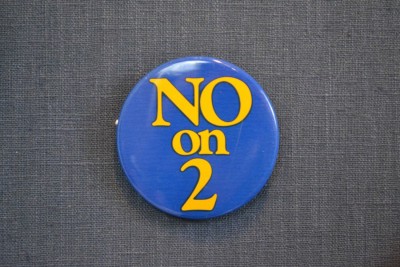
This is a blue button with yellow lettering that says “No on 2”. Under the lip of the button in small lettering is “Paid for by the Oregon Committee”.
Pin c. 1949
X2011.016.0004
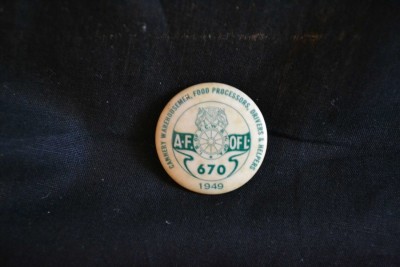
This is a circular pin with a white background and green lettering that says “Cannery Warehousemen, Food Processors, Drivers & Helpers”.
Pin c. 1951
X2011.016.0005
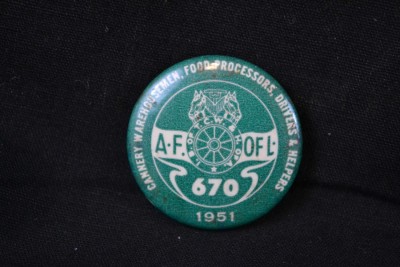
This circular pin has white and green lettering that says “Cannery Warehousemen, Food Processors, Drivers & Helpers”.
Badge
X2013.010.0039
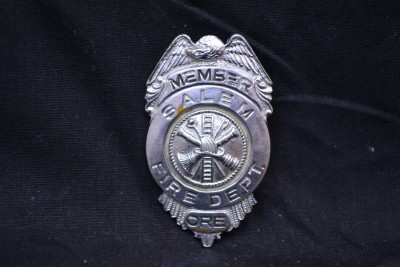
This is a silver colored metal badge. this badge is circular with an eagle visible above and below the circle. In the center is molded the image of a fire had crossed by hose nozzles and a ladder. On back is a long metal clip.
Salem Tech Jersey, c.1966-1968
WHC 2014.044.0002
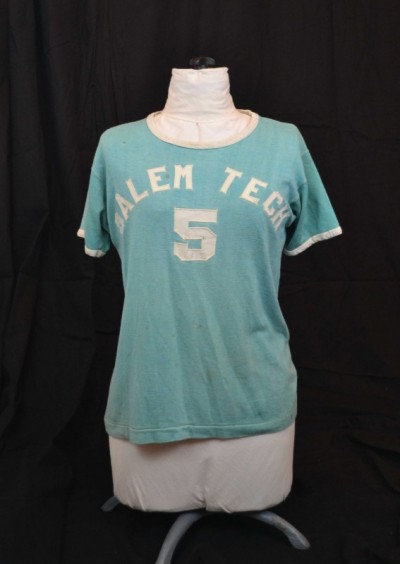
This jersey was worn by the Salem Tech Basketball team under the coaching of Keith Showers. Salem Tech would become known as Chemeketa Community College in 1969. Coach Showers was the school’s first basketball coach and continued to mentor students until his death in 2014.
Salem Technical- Vocational School was originally operated by the Salem Public Schools. It was fully functional as a vocational training school, complete with welding shots and sports teams. In 1969, Salem Tech was changed to a community college for the Salem public and renamed to Chemeketa Community College.
Sanitary Shirts c.1914
WHC 0089.011.0001
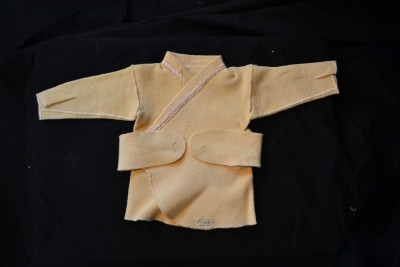
This shirt above is an individually wrapped sanitary shirts for infants that was sold in stores in the early 1900’s. This shirt was purchased by Eula Baumgardner and has a penciled in note from here about her concerns for her child on the bag it came in.
Old Believer Dress Undershirt, c. 1976
WHC 2009.020
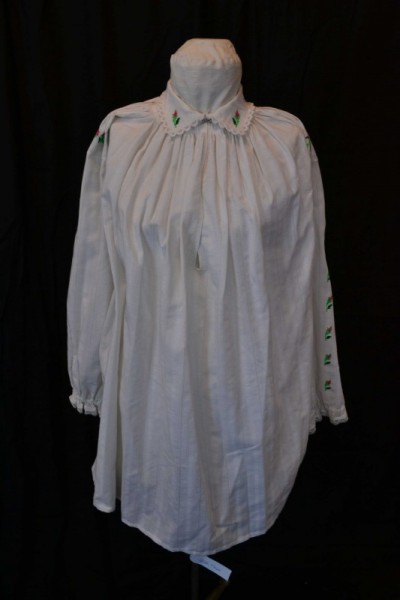
The Russian Old Believers are Russian Orthodox Christians who refused to adopt church reforms in the 17th century meant to bring Russian liturgical practices more in line with Greek Orthodox practices. Persecution in Russia scattered Old Believer communities across the globe.
This shirt has a cross stitch design of flowers that goes along both sleeves and on the collar. This went under the Old Believers dress that is shown in the Dress section.
49’er Jacket, c. 1965
WHC M3 1992-012-0001
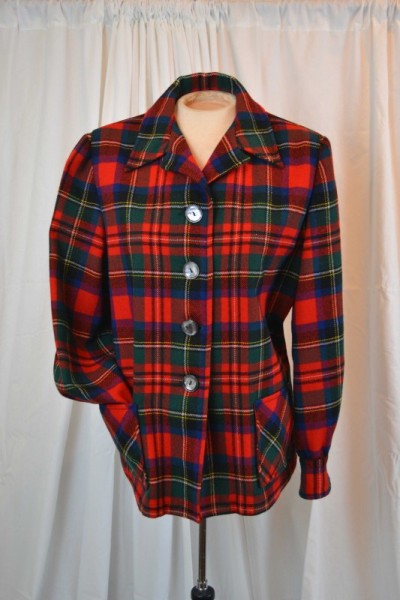
When women began working traditionally male jobs during WWII, they often borrowed clothing from their absent male relatives that was better suited for the work. Post war clothing manufacturers, like Pendleton Woolen Mills, capitalized on this trend and introduced a women’s sportswear collection in 1949. The 49’er jacket was modeled off of men’s shirt designs and became extremely popular. This particular jacket was purchased at the Meier & Frank Department Store.
Thomas Kay Woolen Mills Mackinaw Jacket
WHC M3 1992-009-0001
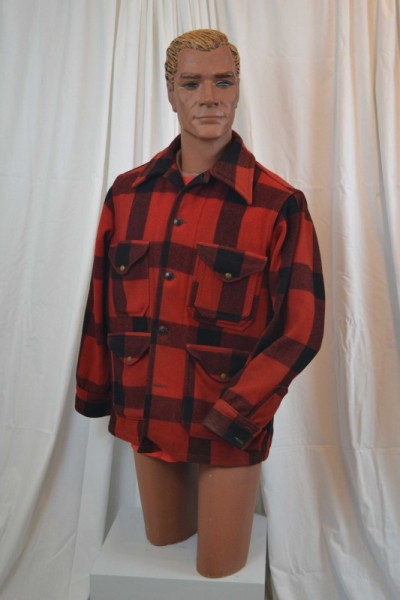
Known for their wool shirts, the Thomas Kay Woolen Mill opened in 1890 to continue the budding industrial and economic growth in the Willamette Valley.
Racing Jersey, c. 1970
WHC 0095.011.0001
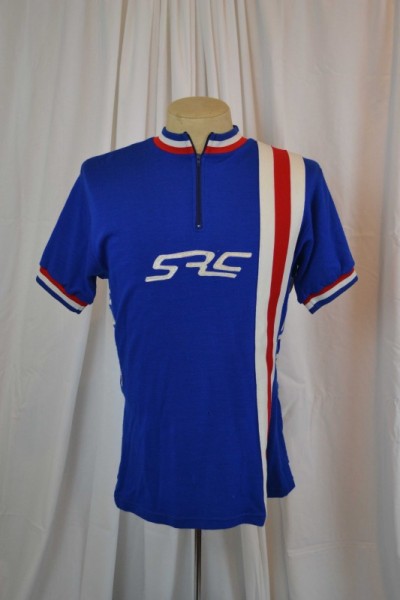
This jersey was manufactured specifically for sporting activities such as racing. This is shown via the material used and the placement of the zipper. Inside the jersey, it has a manufacturer’s tag reads: “Since 1934.”
Wilson Durbin House Shirt
WHC M3 2015-010
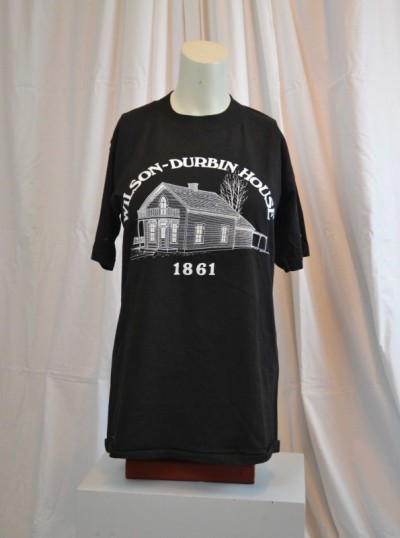
These shirts were designed by local artist Bonnie Hull and sold to support the effort to preserve the Wilson Durbin House. Unfortunately, the house was destroyed by fire prior to the end of the restoration efforts. A replica can be found today at the A.C. Gilbert House Children’s Museum.
Vest
WHC M3 1989-022-0001
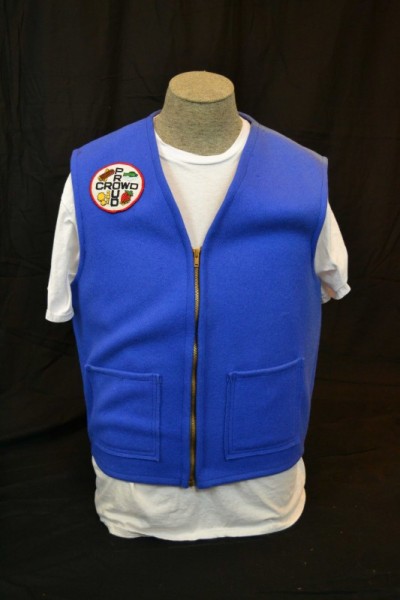
This is a medium blue wool melton cloth vest with a dark blue patch reading, “Jaycees Salem, Ore.” and a machine stitched silver and blue copy of the State capitol building on the back. The front white patch says “Proud Crowd”. This vest has Thomas Kay Woolen Mill Co. label on the inside neck edge and has a label marked “L”. There are two square patch pockets on the front of the vest.
Blouse, 1902
WHC 0084.004.0007
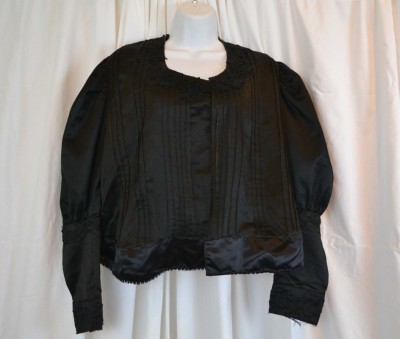
This blouse was made by a seamstress in Onarga, Illinois in 1902 for Ida Beesley Eyre in preparation to visit her sister, Mrs. John Ferguson, who at the time lived in West Salem.
High Heeled shoes c. 1961-1970
WHC 0999.136a,b
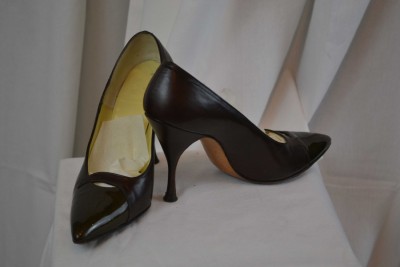
These are high-heeled women’s dress shoe. They are M&F Originals that are bright dark brown with brown leather at heel in addition to the leather soles.
Dancing Slippers, c. 1880
WHC M3 1993-002-0003
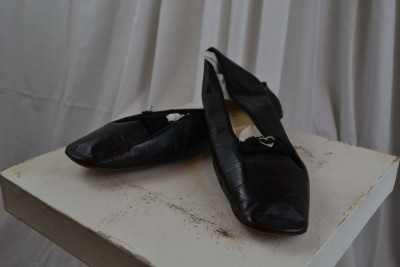
These shoes came from the R.S. Wallace Family (think Wallace Road in West Salem). These probably date to the late 1800s, but are similar to styles as old as 1845.
Dress Shoes
WHC 2014.029.0003a
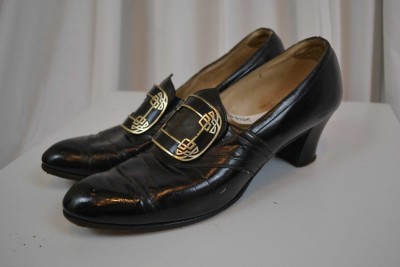
These dress shoes are black with a gold and black buckle for decoration. It is made with a shiny leather with two-inch heel.
Mill Gear
WHC 2009.088

The gear in the case below belonged to Jacob Neufeld (1919-2005). He worked at the plywood mill in Valsetz for 42 years; up until two months before its closing in 1984. His spiked, caulk (pronounced cork) boots would have protected him from the mill machinery.
Leather Boots c. 1904-1913
WHC 0063.001.0029.001
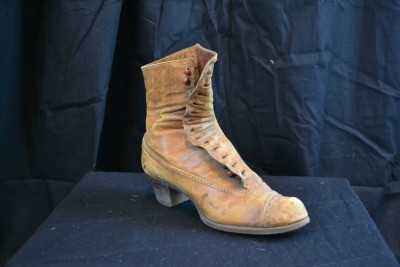
This is a brown leather women’s boot with buttons on the side. It has a cotton innersole inside. There is a label that says “Oregon Shoe Co., Salem, Oregon” inside the shoe top.
The Oregon Shoe Company operated out of 281 Commercial St. in 1904, then 175 N. Commercial St. from 1905-13. It disappeared from the City Directories between 1915-27, possibly due to the remodeling of their building, but then reappeared in 1928. Until its closing in 1935, it operated out of 326 State St.
Baby Shoes
WHC 999.400
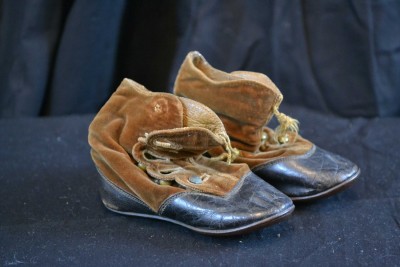
The box these shoes were found in reads: “Rosa Aletha Sterling’s First Shoes”.
Suits
Black velvet suit
WHC 0999.173a,b
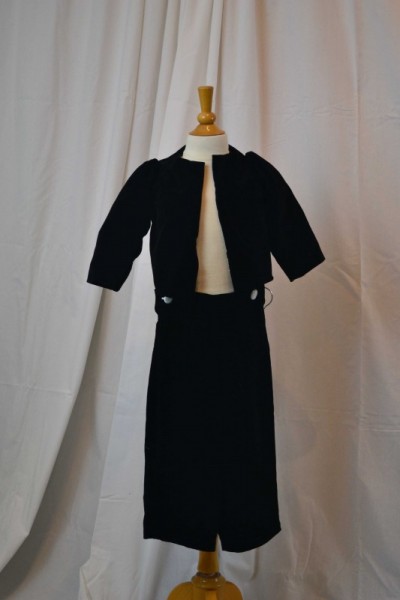
This little suit was made for a toddler-aged child. It is lined with white satin and has two big, white buttons on the bottom of the suit top.
Swimming Suit, c. 1920
WHC 2012.064.0001
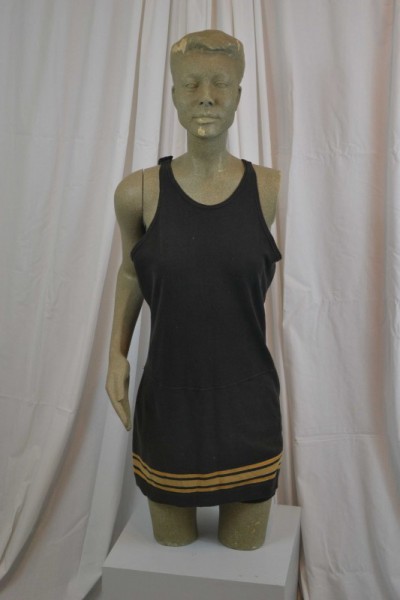
This suit was found in an attic in Turner. Although many suits of this period were made out of wool, this one isn’t.
Uniform
Uniform, c. 1918-1924
WHC 0083.001.0009
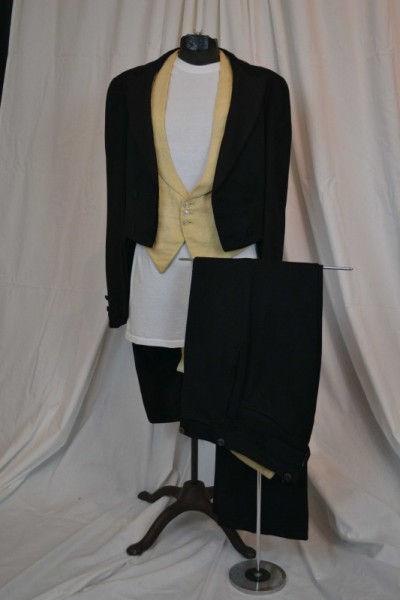
This formal attire belonged to either Frank or Olin DeWitt, brothers who both sang as members of the Salem based Apollo Singing Club. The Apollo Club traces its origins to a winter night in 1914, when Art Wallace, Fred Schwab, H.F. McInturf and Weller Chamberlain decided to form a singing quartet. When duty called Salem-based Company M to the Mexican border in 1916-1917, the group took a bit of a hiatus. Upon the return they expanded the quartet to a full male chorus with 29 members by 1920.
Salem Senators’ Uniform, c. 1951
WHC 2014.082.0127
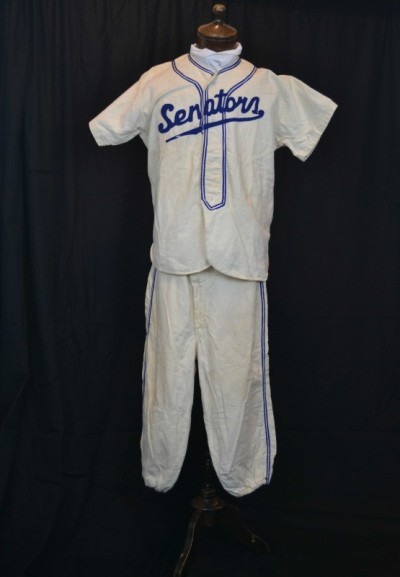
Salem’s minor league baseball team from 1940-1960 was the Salem Senators. Based on photos of the team we have in the collection, this uniform with the blue piping down the front seams most closely resembles that worn by the ball boys in the 1951 season.
Red Cross Nurse’s Aide Uniform, c.1945
WHC 1989.027.0001a
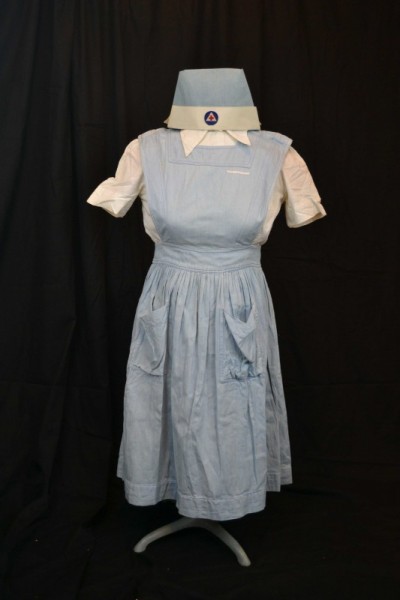
During WWII over 200,000 women served in the Red Cross’ Volunteer Nurse’s Aide Corps in the U.S. They served 150 hours a year assisting with low level nursing services at hospitals across the Home front. They had a strict uniform, shown above, that they had to wear while on duty.
Merchant Marine Uniform
WHC 0999.079.0001, 0999.079.0002
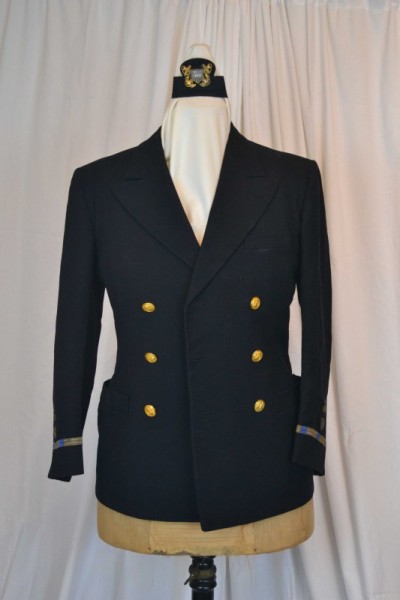
The identification of this uniform is difficult. It is labeled in our database as Merchant Marine, symbols on the various insignia are closer to Navy or Coast Guard designs. The gold rank stripes with blue breaks on the coat cuffs were typical of WWII Navy and Merchant Marine Warrant Officer uniforms. The propeller-like specialty insignia above the rank stripes was used by all three branches to identify an engineer or machinist, but the Merchant Marine also had a laurel leaf surround. There are several button designs on the coat. One, an eagle clutching a horizontal anchor, suggests a Naval officer’s button, but others, with a vertical anchor, are like Merchant Marine buttons.
Merchant Marine Uniform Hat Band with metal insignia
WHC 0999.079.0003
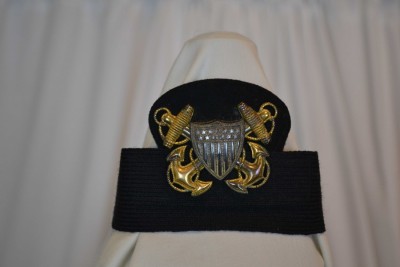
The hatband insignia—a shield in front of crossed anchors—was worn by Coast Guard Warrant Officers.
U.S. Army Jacket c. 1942
WHC 1989.009.0001.001
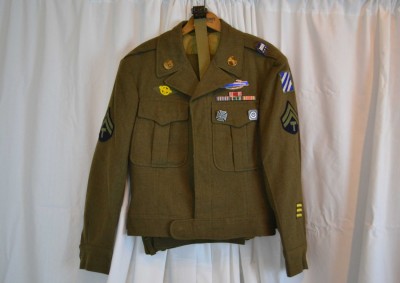
This Army jacket was part of a World War II era uniform. The jacket is decorated with: 2 Lapel Pins, Service Ribbons, 4 Pins, 1 Patch with spreader wing Eagle, Shoulder Patches, Sleeve Patch, Combat Infantryman Badge.
Loren D. Foreman was called into the Armed Forces in 1942 and took his training at Camp Adair with the 70th Trailblazers Division. From there they were shipped to Fort Leonard Wood, Missouri and from there to Europe, where he served as a Motor Sargent in the Infantry.
Foreman did not serve with the 70th Trail division because of the shoulder patch on the Jacket. The patch is of the 3rd Infantry Division not the 70th. The 70th divisions patch is denoted by an axe, a lone tree, forest, and mountain in the background. The third Infantry divisions patch is denoted by a square with 3 white stripes and a green boarder which is clearly on the left shoulder of the jacket.
The insignias on the jacket denote that he was a technician fifth grade (upper sleeve rank, both sides); He was overseas for at least 18 months denoted by his overseas service bars on the left hand sleeve collar; He wears two skill badges, one for marksmanship (level: marksman) on the further right denoted by a plain cross, and a driver/mechanic badge closer to his chest directly to the left of the marksmanship badge. The lapel pin worn on the right side is the enlisted US symbol, and on the right side the pin denotes the specific branch of the soldier. The branch that he belongs to is infantry denoted by the cross rifles on the pin. Both officers and enlisted wear infantry cross rifles however the officer pins do not have the background and have only the rifles and not the disc behind. He also wears the Honorable Discharge Emblem above the right breast pocket to denote honorable discharge status. Ribbons worn on the left above the breast pocket include from top to bottom (left to right): World War II Victory Ribbon, (possible) American Campaign Ribbon, unknown, Reserve Component Achievement Ribbon.
Men’s Uniform Band Jacket for “Cherry Bud Band”
WHC 1989.013.0002.001
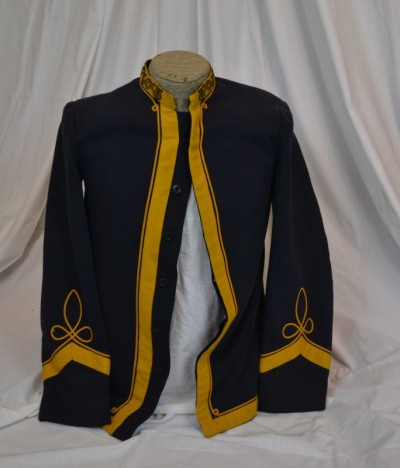
This is a navy Blue wool/felt jacket with 6 buttons, gold piping and trim on the sides and sleeves, and a metallic floral trim around collar with 2 metal lyres. The tag inside says – “Chas Heber, Salem, Oregon”.
The band played at the Oregon State Fair each year and at the Rose Festival as well as the Cherrian event in Salem, during the 1920’s.
Evelyn and Charles Hebel’s Uniforms, c. 1917
WHC 1989.013.0001, 0002
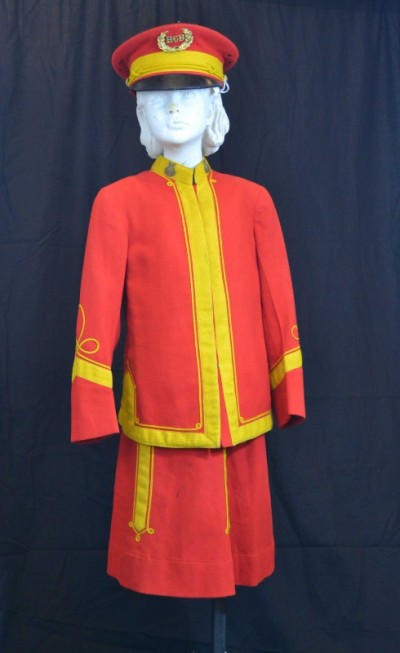
Salem sign painter Charles Hebel started Hebel’s Cherry Bud Band in 1915. The band was made up of boys ages 9-14, with the exception of Hebel’s own daughter Evelyn. Not one to shy away from a challenge, the 46 pound, 9 year old Evelyn played a huge bass horn. She even received compliments from renowned band leader John Philip Sousa when the band performed for him in 1917.
One newspaper account reported of Evelyn: “The clear, strong and musical notes of the big bass swell out in wondrous volume at the pressure of the little cherry-red cupid’s bow lips. The solo work was thrilling, the bell-like notes causing those queer little tingles that chase one another up and down one’s spine.” Her uniform was similar to the rest of the band with the exception of a skirt instead of trousers.
Dance Costume, 1952
WHC 2011.017.0003
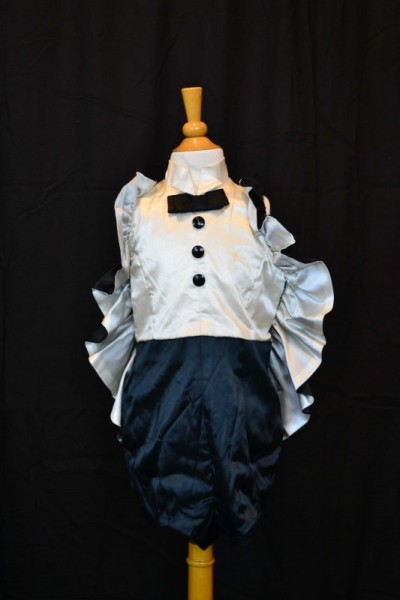
This costume was worn by Barbara Marquam for a recital with the Paul Armstrong School of Dance in Salem. Goldie Drake Marquam, Barbara’s grandmother, sewed this costume on her treadle machine because they didn’t have the money to pay a professional.
Corselet. 1910
WHC 0063.001.0076.012
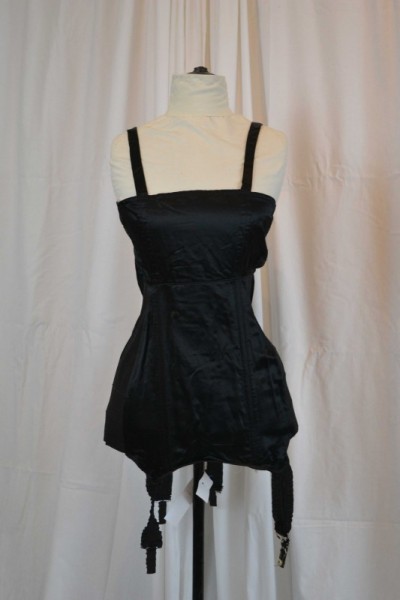
This is a black satin corselets. It is built to be form fitting. According to the tag, this is a Model 2075 corselets and is a size 36.
Crinoline Frame
WHC 0063.001.0020.001.01
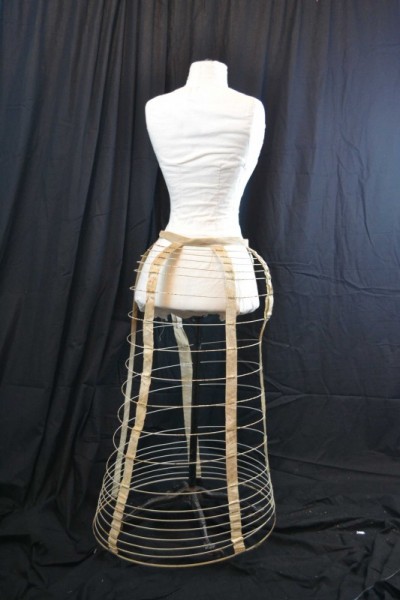
This frame was probably used for dressmaking, not worn, but the construction of hoops and tape is similar to those that were worn. During the Victorian era, giant skirts and tiny waists became the major fashion. Made out of steel or crinoline and fabric, hoop skirts were designed to add volume to dresses. The fabric of the dress or skirt then needed to be designed to go over the top of the cage.
Union Suit, c. 1910
WHC 0999.263
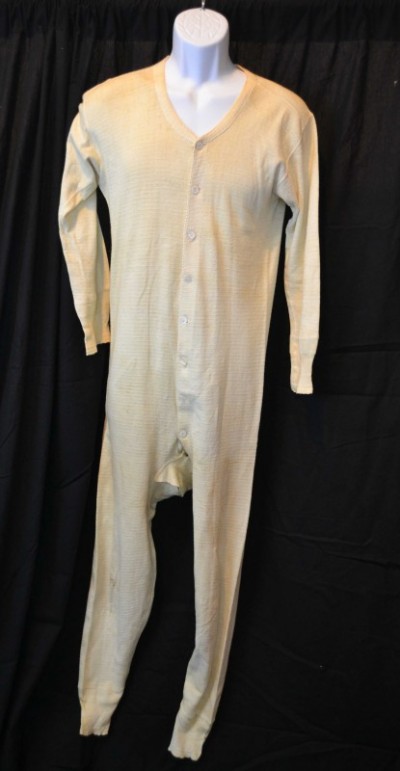
Men’s undergarments for most of Salem’s history consisted of drawers and undershirts, or combinations like this one here.
Cotton petticoat
WHC 1987.004.0004
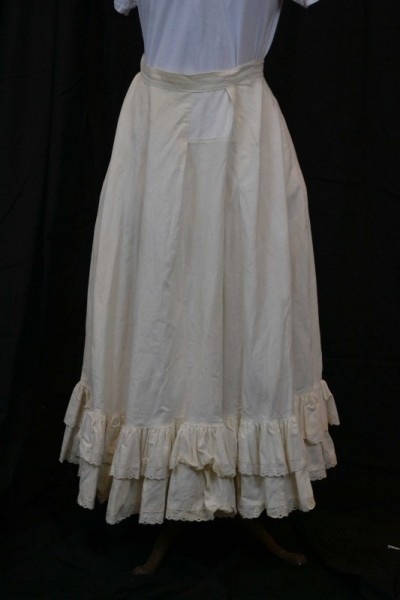
Petticoats like these were used by women to give more shape to their outfit and to keep their dress from getting dirty via sweat. The more petticoats a woman wore, the wider their hips looked.
Camisole
WHC 1991.029.0003
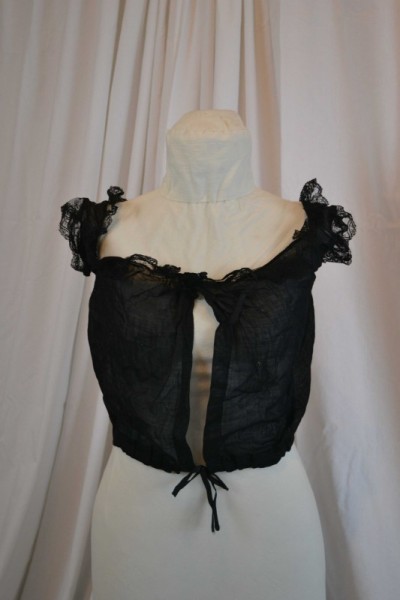
This is a black cotton lawn camisole with black, hand applied lace. It has a drawstring waist in order to adjust the tightness of it once it was put on. This belonged to Susie Sage Chamberlin, who was born on February 4, 1870 in Kasson, Minnesota. She eventually moved to Oregon in 1901-1902.
Child’s Dress Bodice. Date Unknown
WHC M3 2000-002-0025
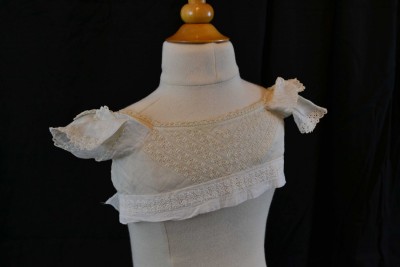
This is a child’s dress bodice, made of both a sheer cotton and denser cotton. It had a machine eyelet and fagoting design on top in a diagonal pattern. The sleeves are gathered open sleeves with matching eyelet lace on edge and a separate ruffle around sleeve, solid on bottom and open at shoulder. It has a drawstring for closure at back. This bodice appears to be hand sewn.
Baby undershirt
WHC M3 2000-002-0021
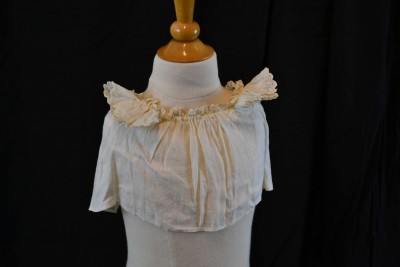
This is a linen baby undershirt. It has a draw string in the front, with bobbin type lace on entire neck edge. The back neckline is gathered into a yoke with a button closure with the button currently missing.
Pantaloons
WHC 1988.055.0005
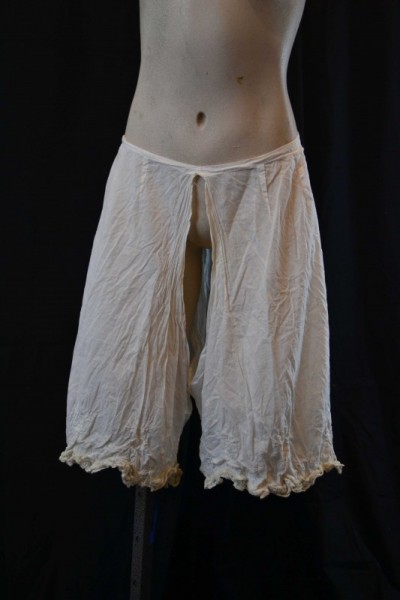
These are pantaloons or pantaletted (also called “easy p’s). It was designed with open legs. These were cotton woman’s underwear with a drawstring waist. There is lace and embroidery at the bottom of leg openings.
Child’s Slip c. 1833
WHC M3 1988-005-0003
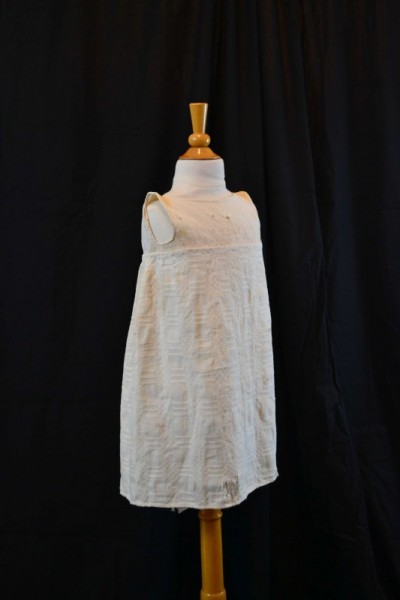
This is a white colored textured linen slip. This has a sleeveless design with a drawstring at the neck. Slips were used as the basest of undergarments, with most other undergarments going on above these.
Petticoat c. 1830’s
WHC M3 1993-011-0001
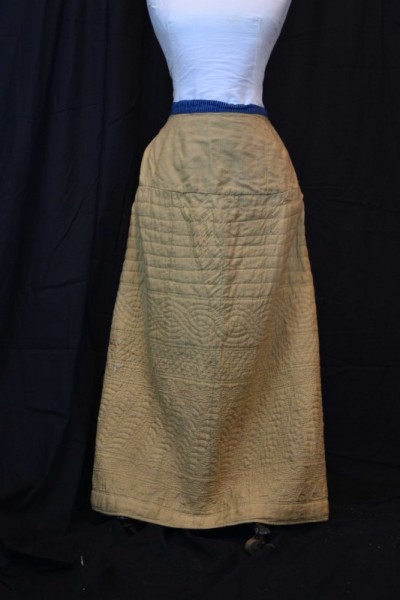
This petticoat was made with a tan fabric with some color stripe. It is hand quilted linen with a brown plaid. It ties at waist, with a hook and eye at the hip.
Crinoline
WHC M3 1983-011-0002
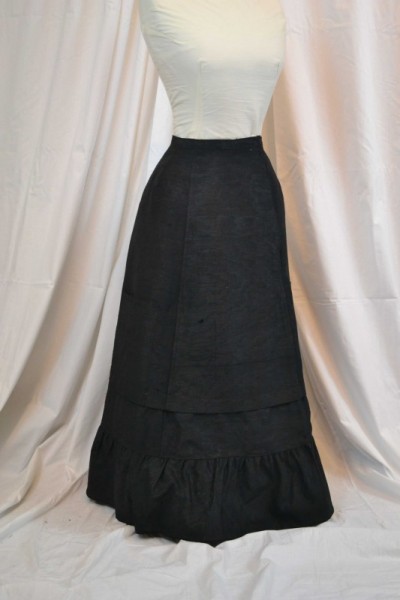
This crinoline is made from horsehair, which gives it the more rigged feel that petticoats.
Corselette, c. 1915
WHC 0063.001.0026.012
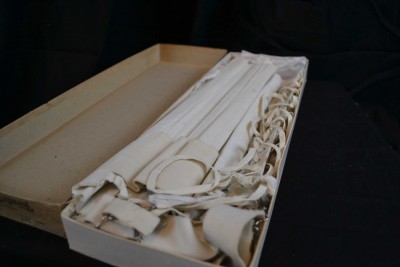
This corselette was made by the Formfit Brassiere Company out of Chicago. It uses elastic fabric to achieve compression along the waistline. As popular undergarments evolved the waist area would disappear leaving a thin bust cover that became known as a brassiere or bra.
Garter c. 1910
WHC 0063.001.0035.007
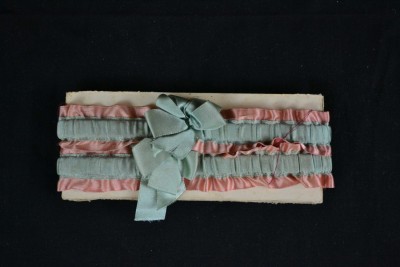
Before their symbolic role in the traditional Western wedding, garters were used to prevent women’s stockings from slipping underneath their clothes. Placed above the knee, rubber or elastic was used to keep the stocking, as well as small valuables, in place.



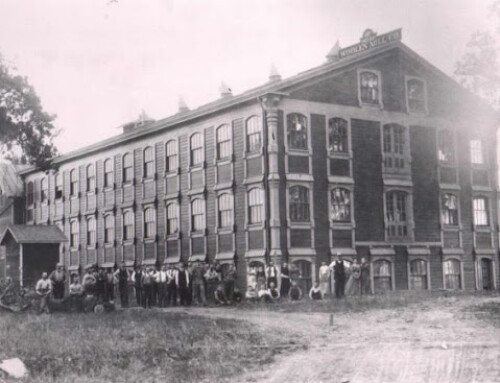
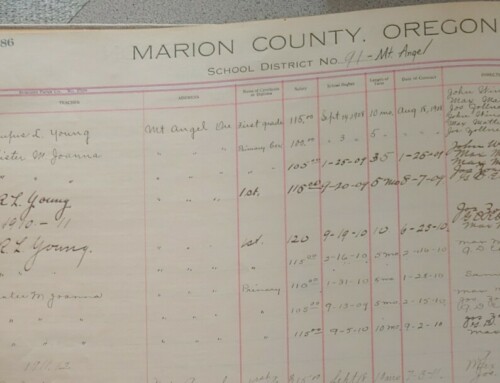
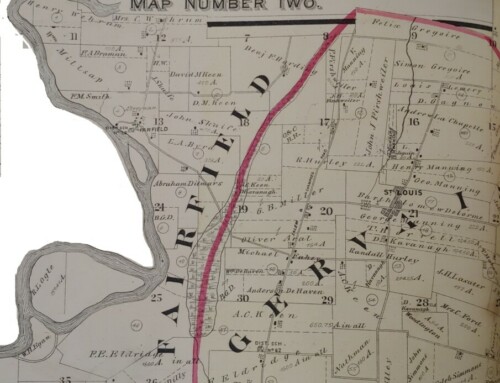
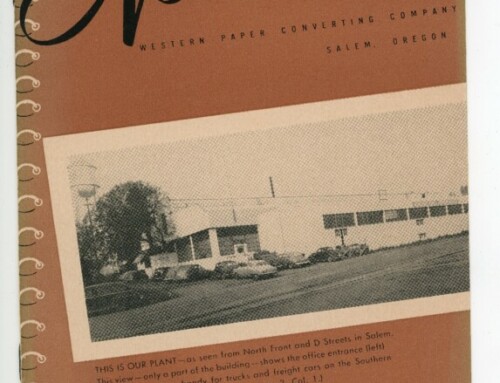

Leave A Comment